#where they talk about history and also wear historical fashion and it’s an aesthetic I aspire ti because it’s just so good??
Text
I forgot how good of a coping mechanism(stim?regulator/??) that doing makeup is until I just did makeup the other day coz I knew I’d need a moral boost to get through the day and something to focus on while I did other stuff. then reminded again today when I knew I needed something to steel my nerves for the rest of the day & to make stuff easier. I felt way better about stuff and it’s making me remember I was gonna get more makeup stuff and I just keep forgetting which is problematic considering how helpful makeup is for me
#thoughts#Oni talks#I did all pink color coding with a reject dress for the wedding and a lipstick I forgot to bring/decided against bringing#that I wish I would have brought coz it would’ve been perfect for one of the outfits#so I just really wanted to wear that lipstick which I originally got on a whim for myself and not to wear anywhere coz it’s kind of a lot#but I find myself wearing it all the time by myself coz it’s just nice idk#and then today I did all purple#and either yesterday or the day before I decided ti be goth with my fancy shirt#which also reminds me i wanna get more of those clothes especially since I was watching this one YouTuber#where they talk about history and also wear historical fashion and it’s an aesthetic I aspire ti because it’s just so good??#and we look vaguely similar too so I know it’s an achievable aesthetic which makes me want the clothes even more#oni talks#the only downside to makeup is that I have to take it off#but yeah again today I was realizing I need to get more stuff partially bc some of my stuff is ridiculously old so it’s kinda weird#& I’m unsure if I should still be using some of it tbh + I’m almost out of some stuff#and the other stuff just doesn’t have enough colors? especially since I like doing color themed things which just yeah#the problem is actually shopping for makeup is surprisingly hard bc I never know wtf to get#also still sad I lost some of my favorite makeups and I lost stuff again and idk where it went :(#I really should learn more about makeup as well but learning hard#I’ve found I also am always torn on whether or not I wanna do mascara bc I really love how it looks but it’s the WORST to clean#like genuinely hate trying to remove mascara it also messes with my eyelashes and just blegh#but like at the same time most looks never look complete without it so??#I also gotta get more lips bc as I said I like color theming and I just don’t have many colors that aren’t like basic af#except maybe blue I had a ton of blue for some reason but that was one of the things I lost! I tried to find this one lipstick the other day#since it’s the darkest lipstick I own and I wanted to be goth but I couldn’t find it and purple didn’t work so I had to do red#and like yes red works with everything but it also gets boring after a while ok#I also probably should get new brushes and eyeliner bc my eyeliner is… rough tbh#I thought I ordered a new eyeliner but idk if they actually delivered it tbh#makeup is one of those things I don’t buy for a really long time and then the one time I do I get a bunch#and then I don’t get any for like a bunch more time again
1 note
·
View note
Text
some of my favorite YouTubers! Some of these are coquette but some of them are not, so I’m still going to tag the coquette tag but it won’t apply for all of these
CZsworld, a horror themed channel that focuses on the intricate histories, theories, characters and stories of many horror movies, books, and sometimes tv shows. He also talks about people/figures from real life in more parody-esque horror history videos. He’s extremely cool and an amazing channel to watch to get into the Halloween mood during October, but watching him at any other time is enjoyable as well
glamourdaze, a collection of different videos from the 20th century, such as beauty and healthcare videos, or just videos of people from different decades in this century living out their lives. What makes this channel one of my favs is that they revive the clips of people from decades such as the 1920s to color them and slow them down (to make it look less choppy and more realistic in how the people move) and it really gives a whole new different perspective on these eras and makes us realize that this wasn’t too long ago.
Erin Parsons Makeup, a very talented makeup artist and vintage collector who’s really cool and someone I love seeing talking about makeup and fashion from history. She’s very similar to glamourdaze except she mainly focuses on vintage/antique fashion and recreates retro looking styles in her looks and it’s just really neat :>
Schafrillas Productions… yeah he’s just very neat and I like watching his movie/tv show reviews. Though his content where he’s passionate and excited about a piece of media is enjoyable, watching him rip apart something he genuinely despises with an infinite amount of rage is funny as all hell
Micarah Tewers, a very talented, artistic, and funny seamstress who makes different types of dresses and outfits in her videos. I love how much dedication and detail she puts into her work to make it stand out and look amazing whenever she wears it, and I also really enjoyed her prom dress videos. She’s also really funny and I love all the extra hijinks she shows herself getting into in between making her project and the video itself lol
Nylijah Myeesah, aka the channel of @/lovesickbrat is a really great coquette channel, and she also has some very good points on different parts of the coquette community and how some aesthetics (such as traumacore or doelet) need to be criticized more because of what they promote.
Colin LooksBack, a Disney based channel that focuses on the characters and movies/other media from Disney, as well as the behind the scenes details of how classic Disney films were made, especially the animated movies made during Walt Disney’s life/career
Karolina Żebrowska, a history fashion themed channel that you probably have heard of. She makes a lot of historical videos as fashion videos and she’s just very talented and intelligent and you should check her out.
Finally, Lavendertowne, the channel I have the fondest YouTube memories of as she was the one who inspired me to start art. I used to love her creepydrawstas and her videos where she drew different stuff as people, as well as her art tutorials. I wouldn’t have gotten to my point in my art journey if it weren’t for her, and overall she’s very cool and sweet.
#pinkspidey’s rambles#youtube#youtumblr#youtube channel#coquette#coquette community#coquette aesthetic#coquette dollete#dollete#coquette blog#vintage coquette#vintage aesthetic#vintage#americana aesthetic#americana#americana coquette#coquette americana#lana del ray aka lizzy grant#lana del rey#lana del ray aesthetic#lizzy grant#coquette fashion#dollette#bubblegum coquette#gloomy coquette#key west kitten#coquette angel#coquette noir
33 notes
·
View notes
Note
Hi! Your lolita coord looks absolutely lovely, and I have a question. I'm just starting to wrap my head around lolita so I dont know that much, but I do know a bunch about historical fashion, and I wondered why chokers arent lolita? From what I've seen, lolita takes a lot of inspiration from Marie Antoinette time France (I dont know the proper era name in english) and during that time, wearing a (red) choker was a way that the nobility remembered their friends and family who were guillotined, so it would match from a historical perspective and (as your coord shows) it matches very well from an aesthetic perspective. But I have the feeling I dont fully understand how historical dress influences and inspires specific lolita styles (there are so many different styles, and it's very hard to figure out where to start researching apart from looking at amazing outfits online haha)
Thank you! So this is an interesting question, because it brings up one of the most interesting parts about making a cohesive coordinate.
So, for starters, the main thing about chokers was that they were considered an ita halmark, or a thing that people assumed was common in lolita and but that really isn't. You could use it to identify a new wearer who did not do their basic research. Choker collars were big in anime wear, so people who hadn't researched lolita and just assumed what it was from watching anime would assume that it was acceptable in lolita. This also includes cat-girl collars, which were usually worn along with cat ears, being a 2/4 on the Ita Outfit Checklist of old.
Choker necklaces also had a kind of sexy connotation to them for a while. Literally everyone who shopped on etsy in 2016-recent times was really tired of finding choker necklaces made of raschel lace that say "daddy's plaything" on it in the lolita tag. Chokers weren't really worn by mainstream fashion for almost a decade, so when they were being worn in lolita, they looked out of place. To try and mentally place that item, people would try to link it to its mainstream counterparts, which often were fetish wear or anime wear.
Basically, at the time, wearing a choker was not a super common thing to wear at normal times, so when you included it in the coordinate, people would try to figure out why you thought it contributed to the look. There wasn't anything particularly wrong about it, but it looked odd. It wasn't normie wear, so it had to exist as being lolita wear, and it just wasn't inherently lolita. They're still not inherently lolita and don't have an established history of being a normal lolita accessory, but they now once again exist as normal wear, so it's not as out of place. That said, there's a lot of lolita looks through the ages who pulled it off and made it look really good. It wasn't always an ita trademark.
The history about the choker in France is super cool! I didn't know that! However, there's something about committing to the bit that needs to be aware of in lolita fashion. The fashion itself draws a lot of vibes from Rococo France, as well as Victorian, Edwardian, and generally absurdly opulent historical garments. However, there's a lot of sub styles that don't draw from that specifically as much as drawing from the general idea of the fashion that shaped that. This is a weird distinction and it's kind of hard to explain, so it's also very easy to overlook something that I can barely put into words.
I was talking about it at the panel (I think. A lot of what I said is now a blur) about how working outside concepts into lolita fashion requires basically committing to everything being either lolita, or a specific element of the thing you're working in. If you're doing punk lolita, all your elements should look either lolita, or punk. And you can do this with other styles.

For example, here's @trickstercheshi in their really lovely ott coordinate. If they'd wanted to take more elements of historical France and work that into the look, it'd either make it look more French OTT, or more lolita. But putting a super 2010 Sweet element here would take away from the look and make the coordinate more confused. It would lose focus and start looking much more strange.
And that's an important thing to focus on in lolita, and something that's hard to do when you're first starting out. There's a lot of history and a lot of things you'll see in lolita that aren't particularly obvious initially why they are where they are. I think a good example of this is Chocomint-style star clips versus gothic halo tiaras (I'm writing this at work or I'd include pictures, remind me later), which are both common in certain lolita looks but not always normal in every coord. It becomes important to look at different sub-styles, to know what fits in where.
I probably have more to add here but my lunch is over so I hope that helped someone.
145 notes
·
View notes
Text
Symbols: Flannel
Being able to write an essay about Deborah Vance’s flannel shirts is going to go down as one of the gayest moments of my life and I couldn’t be happier about this.
Let’s do this.
The History of Flannel in Lesbian Culture
Flannel shirts are stereotypically associated with lesbians, sure, but let’s discuss why that is.
Today flannel is still used as a visual shorthand to indicate a character is a lesbian in visual mass media for a primarily heterosexual audience.
But as with many stereotypes, there exists a grain of truth.
Slate producer June Thomas:
“The association between lesbians and flannel likely began at the advent of women’s trousers. Because jeans were once the only acceptable trousers women could wear in public, and lesbians spearheaded the trend, the flannel-and-denim look was a natural fit given how well they coordinate.”
We’ve added a potentially interesting layer which is that lesbians wearing flannel also is tangled up in the history of feminism and gender equality, issues that are close to Deborah’s heart (which we’ll talk about more later).
But flannel (as with many recognizable queer fashion pieces) isn’t just about aesthetics, but was also a way for other lesbians to be able to safely identify each other in times of limited queer rights.
“While the concept of stereotyping is grounded in othering marginalised people, clothing stereotypes are sometimes used to signal and find others who belong to the same group you do. This is especially true for lesbians. It’s one thing to find other women attractive. It’s another thing to show you do find her attractive, and knowing another woman is safe to flirt with is made a lot easier if her clothing suggests she’s not straight.
Historically, lesbian and bisexual women have had to be resourceful and secretive when finding each other. Much of what may be known as stereotypical lesbian fashion today was originally intended for lesbians to signal their sexual orientation to other lesbians.”
Flannel is only of many other fashion pieces that were used by queer women to signal their sexual orientation to other women. There were also monocles, tuxedos, and short hairstyles, in the 1920s and 30s. Snapbacks, Birkenstocks, and pride badges and buttons are examples in more contemporary times.
The Domestic and the Private
When you look at all the scenes where Deborah is wearing a flannel shirt, there are a few aspects that tie all these moments together: each scene is firmly in Deborah’s domestic space, these are treated as incredibly private moments, and they’re all related to Deborah’s hobby of fishing and they all ultimately connect back to Ava.
Let’s focus on the first two aspects: domesticity and privacy.
Deborah Vance is an incredibly public figure. In her first few moments on screen, we gather that we, the audience, are going to be invited into the private life of a very public figure and we’re going to figure out along with Deborah what is her authentic self and what is a performance she plays for the public and how she’s going to integrate these two pieces of herself.
Out in public, Deborah plays the role of the fierce diva incredibly well. Especially with her loud prints and sharp sense of style which promotes the idea of a confident, successful woman who’s not afraid to show off.
In steep contrast, her flannel shirts represent a more stripped-down and toned-down version of Deborah.
Each time we see her wearing it, Deborah has stripped off her makeup and taken off her hairpiece. She’s settling fully into her domestic life now.
I’ve talked about how Deborah’s ultra-feminine aesthetic could, in some ways, be viewed as armor. So if we follow that metaphor, Deborah wearing flannel is her taking off the armor for a little while.
Flannel as a fabric is incredibly practical, again in contrast to Deborah’s usual emphasis on style and feminine beauty standards.
As Slate producer, June Thomas, jokes:
“Flannel is practical, it’s warm, it’s cheerful, it’s comfortable—like lesbians. And yes, it is a sensible, durable fabric, and my people are known for their practicality.”
But the extra kick about this is how the flannel shirts aren’t just a contrast from her usual appearance, but also catch Deborah in a lie of how she presents herself in public.
Deborah’s very first joke and first lines of the show:
“So anyway, of course now, the guy’s on top of me going at it, you know.
[grunting]
T-shirt’s still on ‘cause his breasts are bigger than mine. And I told him--What? I was jealous. So anyway, the dummy starts asking me questions. ‘Are you close? Are you close?’ I’m like ‘Yeah. Yeah. I’m close. I’m close.’ I’m close to getting a buzzcut, a flannel shirt and finally accepting Melissa Etheridge’s dinner invite!”
The way she phrases this joke, Deborah is saying that she doesn’t own any flannel shirts. She’ll have to go out and get one. Which we, the audience, know is a goddamn lie. In fact, she owns not one but several.
And her acting like she doesn’t own any flannel shirts is in response to the stereotype that lesbians own flannel shirts, so firmly reinstating her heterosexual identity despite her previous story of terrible sex with Marty which could’ve put that in doubt.
On a much smaller scale compared to lying about burning Frank’s house down, we’re seeing Deborah lying to the public about herself. Portraying herself in a certain way to play a role. With the house fire, it’s playing into the idea of her being a “crazy woman” while the first joke is playing into the idea of her strictly being a heterosexual woman, and no there are no debates about this, thank you very much.
The larger point is that the flannel shirt represents us seeing a very private side of Deborah that few people get to see because she deliberately hides this from the public and most people, in general.
The only two people we see Deborah with while wearing the shirts are Marcus and Ava. Two of the people she’s the closest with and knows her beyond her public image.
Alongside this idea of a hidden side, we also only see Deborah wear these shirts at night.
Now, obviously, there’s a practical level on this, not going to deny that. Deborah is incredibly busy and spends most of the day working, so it makes sense that she only has time to fish at night.
But let’s still believe the writers did this for a reason. The night is associated with darkness, death, vulnerability, secrets, fear, and intuition.
Nighttime, for many of us, is also a time for reflection, quiet, introspection, rest, and restoration or a chance for our dreams or wants to come out whether through sleep or through sex.
Fishing seems to be the only time that Deborah has a chance for quiet contemplation. She’s not surrounded by others. She simply gets to be.
It is perhaps not a coincidence that Deborah wears this practical, comfortable, pared-down piece of clothing in her moments of introspection, and reflection, and in her moments of exploring her own repressed desires, emotions, and thoughts.
The night is also associated with sleep so also with the unconscious and speaking of that…
Deborah’s Pond
Deborah’s pond is a symbol of her subconscious. The gist of my theory is that Deborah's fishing is symbolic of her beginning to get in touch with her repressed feelings, emotions, and memories due to the introduction of Ava into her life.
Water is a tried and true way to symbolize the subconscious.
“Typically water symbolizes secretive emotions, particularly desires. And these feelings might even be unknown to the person experiencing them and therefore are certainly unknown to others. After all, if the water runs deep, then so do the secrets, the feelings, and the emotions.
So where does the fish come in? Well, fish (trout are no different) swim through the secretive waters. As such, fish represent the movement, energy, life, motion and constant evolution of our thoughts, desires, and emotions.”
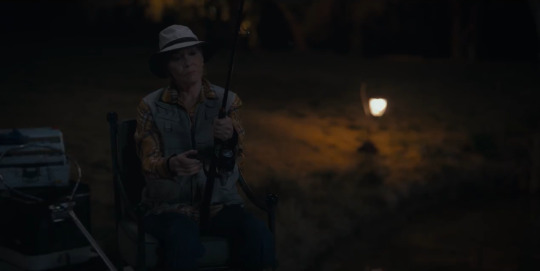
That she wears flannel while she does this suggests we are seeing a more intimate side of Deborah in these scenes. We are seeing a side of her that she either hides or lies about in her public life, as discussed above.
We see Deborah unearthing memories and feelings she’s been repressing in the first two scenes we see her wearing the flannel shirts.
Deborah finds Ava watching her unaired late-night pilot and becomes incredibly emotional over it. Why? Part of it is the renewed grief over the career opportunity that was taken from her and the personal betrayal from Kathy and Frank, but another part of it (as I see in the very next scene) relates to Deborah herself.
The late-night pilot shows who Deborah was before her character wound.
A character wound is a painful past event that changes who your character is. In psychological terms, it’s called the ‘negative core belief’, whose definition is almost identical to that of a character wound – ‘a negative, broad, and generalized judgment an individual has made about themselves, based on some negative experiences they have had during their earlier years. Whether you define it intuitively, or scientifically, in essence, it’s a thinking pattern rooted in our past. One that will impact how your character perceives the world, and ultimately the choices they make.
Deborah’s character wound is Frank’s betrayal both personally and professionally.
This wound explains nearly everything that Deborah does, especially in the beginning.
At the heart of every character wound, as explained above, is a lie that the character has internalized from their experience. I think Deborah’s lie is related to the idea of “I’m not safe” and so she feels constantly on the defensive, won’t let people in, always assumes bad intentions, and will mold herself into whatever is necessary for self-protection, even if it means sacrificing her desires or her morals.
The Deborah in the late-night pilot is incredibly familiar, but also seems like a different person altogether. She’s more emotionally open and affectionate. She’s more willing to be vulnerable.

She’s steadfast in her feminist beliefs and her desire to make comedy a welcoming place for other women. She’s not cruel.
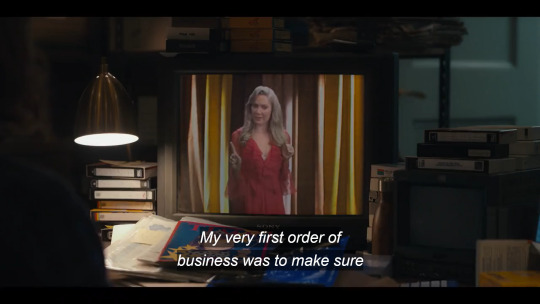

There are many ways to interpret what the fish represents, especially connected to this moment.
I like @jennamacaroni’s interpretation that Deborah letting go of the fish is about Deborah choosing to let go of ruminating about what happened to her. To keep refilling the pond over and over again, constantly trying to re-live the pain and letting it control how she lives her life even after 4 decades. She’s refusing to keep torturing herself with resentment over her lost opportunity. The fish in a way could represent Deborah herself. As Ava says earlier, Deborah is also harsh towards herself. Maybe at this moment, she tries to show that more vulnerable part of herself some self-compassion and let go of ruminating over what could’ve been if that hadn’t happened and instead accept her life as it is.
I have a couple of other interpretations as well.
I think my biggest read on this scene is that Deborah’s long-repressed empathy and compassion come back to her in this moment because she saw a pre-wounded version of herself.
As she is confronted with that earlier version of herself, Deborah can no longer see the fish suffering as she did before. At that moment, Deborah’s empathy and compassion can no longer be repressed and she chooses not to kill the creature just because she caught it.
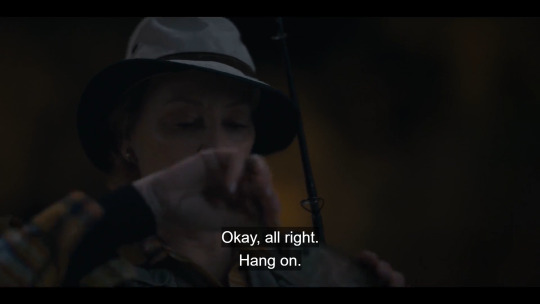
One of the biggest complaints Ava has of Deborah is that she can, frankly, be a bit of a bully. Wilson accuses her of something similar. She’s called an insult comic. I would argue Deborah is actually quite a good person, but in her humor, she has sometimes used it to pick on people who are already vulnerable. She’s made fun of Anna Nicole Smith (the world’s punching bag leading up to and after her death from a drug overdose), she has a set on making fun of Malala’s face, etc.
But Deborah’s biggest punching bag is herself.
Now, I just want to be clear that I don’t think insults being a part of your comedy is a bad thing. I’m not here to argue what is or isn’t good comedy. But I think what the late-night pilot shows us is that, before everything happened, Deborah seemed set on using her comedy as a way to advocate for women’s equality, to push her progressive values, and instead make fun of the powerful who use it to abuse others. Deborah herself wanted to be that kind of comic, but she’s lost her way.
We know Deborah has the capacity to be cruel, as demonstrated earlier in the episode. So once she sees that kind, sensitive, empathetic young woman who she knows is going to be terribly hurt and forever changed, she can no longer look at the fish the same way. She can see it struggling and in pain and feels empathy for it.
Just because she caught the fish on the hook, doesn’t mean she needs to kill it. Just because she has the capacity to use her words and her comedy to put people down doesn’t mean she has to use it for that.
(Season 2 complicates this again and not in a good way. Deborah’s show ultimately doesn’t pay off this thread they pulled out in season 1. Deborah continues to put other people down, including women and lesbians. I guess see this analysis as what could’ve been if this storyline had been more followed through on.)
But another interpretation could be the fish represents more of Ava herself and the love and understanding she potentially offers Deborah. I’ve theorized before that Deborah is very lonely and longs for a romantic partner. Still, one thing that’s also clear is that Deborah hasn’t really opened herself up to that possibility because she’s terrified of being hurt. She keeps looking for the “fishes in the sea” but she keeps killing them. Not letting them stay around long enough to see her. I think there’s also an interpretation that she keeps killing them because she’s trying to repress a desire she’s frightened of (more on that later) and therefore also killing any chance with a different kind of partner. She’s so desperate for control that she subconsciously keeps killing any chances to get what she wants because the thing she wants requires her to let go of some control.
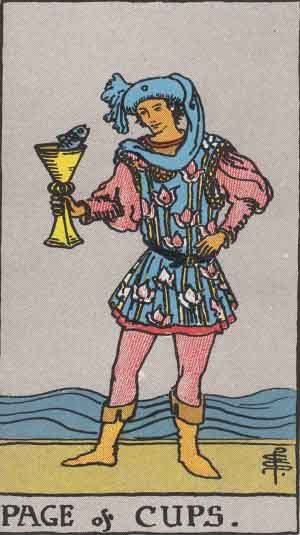
The symbolism of fish makes me think of the Page of Cups tarot card. And we know from 2.02, that the writers are willing to incorporate tarot cards in their storytelling.
“The Page of Cups upright is a messenger and brings good news about the emotional aspects of your life. Some common messages that result from this card are possible romantic proposals, new relationships, an invitation, or good finances…
The card encourages you to embrace these opportunities, despite them being something that you may not expect. If you do so, it will lead to new adventures and open many doors.”
“The fish in this drawing represents the unexpected. Unexpected news, unexpected emotions, or unexpected inspiration are all examples of what could be in the future for you.”
“Think of the Page of Cups tarot card. In this card, the page is depicted holding a single cup. Inside that cup is a fish! The page is surprised by the fish, it is unexpected. And even more surprised is the person receiving the gift of the cup (fish included). The page of cups, in isolation anyway, tells of a new and unexpected offering of love.”
Who is more of an unexpected addition to Deborah’s life than the one and only Ava Daniels?
Deborah sees Ava has gotten closer than likely anyone ever has in a long time. Ava pushes through even when Deb tries to pull up her walls again.
So the fish represents a choice for Deborah, at this point.
Is she going to decide to cut Ava out now before she can get too close or is she going to see where it goes?
To a traumatized person like Deborah, the unexpected can seem like a danger. But they can also represent opportunity. An opportunity that secretly Deb has been waiting for.
But, because it’s a story, we got to have our ups and downs. 1.03 gives off hope when it comes to this symbolism, but now let’s talk about one of the gayest scenes in the series despite that nothing explicitly gay happens.
Deborah is left reeling finding out about Ava lying about her interview. In the interview with the journalist, she talks about Frank and we the audience know Deborah is emotionally comparing the two. Deborah feels betrayed by Ava as she did with Frank. She feels abandoned by Ava.
On top of all of that, we see Ava have to make a choice between selling Deborah out to benefit her own career or choosing to stick by Deborah…and she chooses to stick by her. Not only that, but Ava doesn’t sleep with her ex, Ruby, the night before because of a lesson she learned from Deborah about being professional. Ava shows immense growth and it is explicitly because of her connection with Deborah.
The comparison to Frank is reinforced in the fact that Ava didn’t wrong Deborah as Frank wronged her. She didn’t cheat on her and she didn’t sell her out (ignore the email, that’s another can of worms).
When Ava returns home, Deborah is pissed. Knife-wielding pissed.
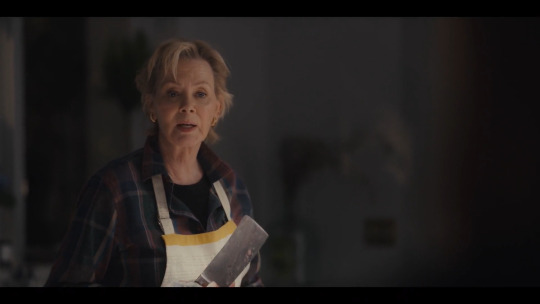
She’s wearing her flannel which we could argue has connotations of queerness, at this point, which is doubly interesting because Deborah and Ava have been roommates for the past 2 weeks and they’ve only known each other for like 2 months. U-haul, anyone? Plus, Josefina makes an interesting remark about her niece also trying to pretend her roommate is simply just a roommate which wasn’t necessary to put in if not to mean something.
Deborah looks like a passive-aggressive wife who just caught her wife in a lie and cheated on her.
Unlike in 1.03 which shows Deborah opening up, she is distinctly closed off in this scene. She is hiding her hurt through coldness and anger. And in the opposite of that episode, she does kill the fish. We see her gut them and chop them up aggressively.
If we continue the symbolism as we analyzed in 1.03, her doing this represents Deborah closing herself off to vulnerability. Closing her heart off to Ava. Closing herself off to the emotions, the vulnerability, and the memories her relationship with Ava has unearthed. It’s not at all surprising in the next episode that Deborah wishes to not do the new show and fires Ava. She’s going back to repressing what has been brought up for her.
Deborah asks Ava to hold the fish while she violently chops it. She refuses to give Ava gloves when asked. This could be Deborah asking Ava to feel Deborah’s raw, bloody hurt of her betrayal with no protection. She wants her to take some responsibility for it, even if she won’t be direct with her. She wants her to symbolically understand that their close relationship is over and that she helped destroy it. It’s also, of course, a warning. A warning of how fierce Deborah bites when a person breaks her heart.
Oh yeah, she also mentions not wanting to chop off any of Ava’s fingers which *long, suffering gay sigh*. Before season 2, I would say the interpretation is that Deborah’s constant jokes about Ava’s hands indicate her attraction to her. So not only is Deborah cutting off any emotional and romantic feelings she’s having for Ava, but she’s also cutting off any sexual feelings she’s brought up in her. She doesn’t literally cut Ava’s hands but she almost wants to destroy the symbol of her attraction to Ava.
(I think my interpretation is now kind of debunked by canon in season 2. But I still think this wasn’t a crazy interpretation in season 1.)
If her pond is representative of getting in touch with her deeper self, her desires, and parts of herself that were buried to protect herself, then those associations rub off on the flannel as well.
The key to Deborah accessing this deeper part of herself seems to go hand in hand with exploring herself outside of the public persona she’s curated all these decades. And what she finds out in this internal journey is likely to be very contrary to what she’s presented herself before.
Okay, so what does all of this mean?
Now, none of this queer history would matter all that much if it weren’t for the fact that the show, and Deborah herself, also make this connection between flannel and lesbian culture.
Deborah: “So anyway, of course now, the guy’s on top of me going at it, you know. [grunting] T-shirt’s still on ‘cause his breasts are bigger than mine. And I told him--What? I was jealous. So anyway, the dummy starts asking me questions. ‘Are you close? Are you close?’ I’m like ‘Yeah. Yeah. I’m close. I’m close.’ I’m close to getting a buzzcut, a flannel shirt and finally accepting Melissa Etheridge’s dinner invite!”
Tied in with the history of flannel in lesbian culture, Deborah’s first joke is using these stereotypes to ‘other’ lesbians as she makes a joke about her unsatisfying sexual experience with a man (one of many she tells *coughs*) but then mocks the very idea that Deb would ever stoop so low to become a…lesbian.
But as demonstrated by the fact that we don’t see her face during this performance, we’re not meant to take this as the truth. Deborah is literally performing for an audience and what we are about to witness for the rest of the show is a more intimate look into the private life of this famous woman. And what we try to discover about Deborah Vance as we watch is how much of her public persona is fiction and how much of it is real. We soon find out that this persona Deborah wields on stage is very carefully constructed.
As video essayist, Tears in Rain, says Deborah’s performance is both defiance and refuge for her and it is demonstrated well in her first joke. She’s being defiant by being open about her sex life (especially as an older woman) and talking honestly about how she feels the need to perform pleasure because of male fragility and ignorance and self-centeredness when it comes to their sexual relationships with women. But she’s also seeking refuge because nothing of real note comes out of any of these jokes about her lack of enjoyment in sleeping with men. She gets to vent her frustration, but no real revelation or change comes of it. She never has to come to a conclusion that might make her uncomfortable or leave her feeling vulnerable to public scrutiny. She can talk about her sexual frustration, but then also distance herself from sexual minority groups in an effort to keep up a heterosexual appearance.
Now, as Hacks is a show with a majority queer cast that makes this show gives the deliberate connection between flannel shirts and lesbians even more weight. They could’ve chosen to not include that. After all, none of the queer characters fit completely well into any particular stereotype.
Because so much of the cast is queer, it’s not necessary to differentiate who the lesbian character is with this signifier unlike in other pieces of media.
The writers want you to notice that connection and they want you to notice that Deborah does wear flannel. Especially considering Deborah is the character who shows the most stereotypical view of lesbians and, as I’ve argued before, the most prejudiced views towards them.
This all ties back into the idea that Deborah wearing flannel is showing us her in a moment where she’s not performing. A moment in which she’s showing something that she’s hiding from her audience.
So if you combine the pond’s association with repressed subconscious desires and feelings with the association of flannel as both associated with lesbians and Deborah keeping secret sides of herself that directly contradict how she portrays herself to her audience, we start to get a clear picture.
The wearing of flannel can be read as Deborah keeping her subconscious attraction to women away from public view. These are the moments when Deborah has the solitude to even get close to thinking about her desires, especially if they are desires for women.
Now, at this point, I think Deborah’s attraction to women is buried fairly deep in her subconscious. Her attraction to Ava comes out mostly as insults about her appearance or surprised (or drunk) admissions and comparing Ava to her ex-husband, Frank.
Before season 2, I would’ve told you that this would all be a great lead-up to Deborah’s exploring more of her relationship to gender and sexuality and possibly even exploring the idea of being queer.
Considering my overall problems with season 2, I can’t say this is true anymore. Especially considering the show’s treatment of lesbians in 2.04 and how the show seemed to balk at the idea that Deborah might be queer.
The messy conclusion of all of this is that I think, especially pre season 2, a queer reading of all this is perfectly logical. Reading the symbolism of flannel as potentially laying the groundwork of Deborah exploring her queer desires doesn’t actually seem that weird.
Do I think the writers will do that? Unlikely. For whatever reason, they seemed to want to move away from this idea and in fact doubled down on Deborah’s homophobia and misogyny in season 2 which was disappointing, to say the least.
I don’t think Deborah will ever come out as queer in canon, but in season 1, if it was intentional, I think the writers created a beautiful visual story of a famous woman who’s struggling with her desires and yearning for authenticity and genuine connection. It could’ve been a beautiful story of a woman later in life discovering something new about herself that she’s long repressed and overcoming her fear. It just wasn’t meant to be this show.
Bonus:
Some of you probably know there is possibly another connection related to this which doesn’t have to do with anything in the show, so much as it does the history of Jean Smart’s career.
For those of you who don’t know.
Jean’s first major role was in a stage play called Last Summer at Bluefish Cove starting in December of 1980.
Jean won awards for this role and, through this, she was discovered and cast in Designing Women. So obviously this was a massive deal for her career.
Guess what the play was about?
“[The play] is a landmark piece in Lesbian dramatic literature as the first mainstream play of its kind.
The play follows eight women over the course of one summer on the fictional Long Island seaside town of Bluefish Cove.”
Jean played Lil, “Sarcastic, witty, and knows how to clean a fish in her sleep. Dying of cancer, but keeping the diagnosis close to her chest. The only single lesbian at the start of the play.”
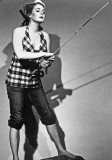
…Do I need to state what everybody is thinking?
Sarcastic, witty, knows how to clean a fish, single…
Sounds an awful lot like Deborah Vance. Well, besides the cancer part. I guess if you wanted to connect it you could talk about how Deborah is towards the end of her life.
Am I saying the writers did this on purpose?
Honestly, I don’t know. Could’ve been just a happy coincidence.
But! It makes for an interesting bonus to all of this.
#hacks hbo#hbo hacks#hacks#hacks thoughts#deborah vance#ava daniels#ava x deborah#deborah x ava#avorah#debava
26 notes
·
View notes
Note
hello!! i hope all is well. i discovered your blog back in october, and i keep coming back to it every once in a while; i'm so in love with it and how you view ariel!! i was wondering, though: if "the little mermaid" took place in the 21st century, what do you think ariel's fashion style would be like once she reaches the land and learns more about humanity? i personally feel like she'd be a chameleon: vintage one day, goth the next, y2k, etc, and just try out as many trends, styles, and aesthetics as possible. fashion and aesthetics are such a cultural experience and can hold deep ties based on regions of the world and how fashion changes throughout history, so i feel like ariel would just eat that up and want to learn more about it and experiment with that. at the same time though, i know that you've talked about ariel and beauty standards in this post (/ariel-isnt-someone-who-cares-about-her-looks-or/a2ebc8rgjw6o), but do you think that there could be a difference between how she'd view trying this out in the human world versus the mermaid world, especially in a more modern world? i suppose that we did sort of get a glimpse into that within the movie itself, though i can't help but wonder what the difference could be based on the time periods as well. thank you!!! i'm sorry if this is a weird question or something sjdfhgkjdf i'm working on becoming a cultural anthropologist and i have a love for ariel as well, so i was curious about your thoughts and what you think

This is so sweet, thank you friend 😭I think you're right on the spot with your assessment of her being a chameleon, because I feel the same way. I think the contemporary trends are to be too focused on naming an aesthetic- even if it's an assortment of multiple types of styles- and Ariel is much too...varied and impossible to be pegged down for that. She would definitely love to learn about different historical periods and how certain silhouettes and materials and structures come from a different time and why they were invented and the functional purposes they served, but I also think she'd have a limit with what she'd be interested in. For instance, Ariel would not be someone who's interested in the color theory market that's being peddled on TikTok. She wouldn't care about what color suited her best "scientifically" or learning about like...the fundamentals of fashion so that she could pull a look together that "objectively" looks good to "fashion people." Here's an example- she loves her pink dress. It's special to her because it's the first dress she wore on land, but even without that context, she really likes it! If one of those color theory specialists tried to tell her the pink clashed with her red hair, it literally wouldn't make any difference to her at all. If she lived in modern times, she'd actually associate the pink and red combination with Valentine's Day and really love it!
I think the main component to Ariel's wardrobe would be color. She's a super colorful person and, if she existed today, she'd definitely have very potent colors in her wardrobe that popped out at you from a mile away. And that's not to say it'd be tacky or like unbearably bright but just very distinctive colors. Ariel's a very creative person, and she wouldn't want to dress like anyone else. I think, in the modern day and age- and in any situation where she's away from her family- she'd feel free in expressing herself in her clothing and would wear things that many people would applaud her for in its novelty, but others would view her as a freak. Like, she might wear a petticoat in the modern day, and super short shorts the next. Her style would also be fun! She would mix and match and it wouldn't really have a structure to it and she definitely wouldn't have a uniform. She would just wear what she likes. She would thrift a ton and mix and match things that she liked, even if they were from different time periods- she isn't someone who likes all of her clothes and accessories to be from like a specific decade, because then she'd feel too much like a museum piece lol coming on to land, initially, she would let others dress her like Carlotta did and she'd feel comfort in trusting their decision and style so that she could better assimilate with humanity and just, in general, taking their word for what would make her look good and what wouldn't...but just like she'd develop and be able to find herself personally the more time she spends on land and away from her family, the same would be true for her style. Once she gets a better grip on it, and frequents a flea market one too many times, she'd get an eye for the type of jewelry she likes, then for the types of scarfs maybe that she'd be into- and everything would be punctuated by her passion. She could be super into frills for a period, and then super into golden items the next, etc and it could fluctuate and she could wear nothing but that one style for a time- so it'd be all over the place, but she'd wear everything so well and it would be so her and this is such a fascinating thing to think about, thank you so much for sending it in!
#ask#anonymous#the little mermaid#the little mermaid 1989#i'd love more friends <3#running this blog is lonely#i want people to share this passion with!#- message in a bottle <
8 notes
·
View notes
Text
I promised, at one point, a post about facial hair in ofmd with regard to its perceived moral value, and I'm currently struggling with some other writing, so here goes. This will be choppy, but you're not my high school English teacher, so you can't dock me points for lack of transitions (if you are my one of my high school English teachers, I graduated almost seven years ago, you have no power here).
Adding a readmore even though there's that new long post feature, because I personally have it turned off because it's annoying, and I don't want anyone to have to suffer through my rambling.
Throughout the series, there's a pretty clear distinction between who wears facial hair and who doesn't.
An incomplete list of people with facial hair, based on a google images search because I'm at a friend's house and can't just rewatch:
Ed
Izzy
Oluwande
Buttons
Black Pete
Jim in disguise
Roach
Frenchie
The Swede (stubble counts)
Pretty much any other crew member because I know I've forgotten at least one
Ivan
Fang
Doug (he gets his own paragraph later)
An incomplete list of people who don't have facial hair:
Stede
The British Navy
The men back on Barbados in episode 9/10
Jim out of disguise (also gets their own paragraph)
Lucius (another one who, you guessed it, gets their own paragraph)
Ed in ep. 9/10 (also addressed later; there's a trend here)
Now, part of this is based in history. In the 18th century, facial hair was out of fashion among the upper classes. In fact, when I was googling the history of facial hair, one of the sources that popped up had as its google preview literally the entire central conceit of this post:
"From around 1700, hair completely disappeared from men's faces all across Europe. Amid new aesthetic ideas about male appearance, facial hair had become associated with a rough, rustic stereotype, which went against the smooth, shorn skin of the 'polite' gentleman."
Now, I know this show is set in the Caribbean, not Europe, but this is the early 18th century, and during this time the Caribbean was all European colonies. The colonists would have largely been mimicking the styles of Europeans, as that was what was "respectable." You can see this in some of the more historically accurate clothes Stede wears (disclaimer: I am not a fashion historian; this is all as just far as I can tell/as far as I know. If anyone with more knowledge on the matter would like to chime in, feel free!).
Stede is making his name as the Gentleman Pirate, which means that of course he's going to be clean-shaven! Otherwise, he's not much of a gentleman at all, is he? No matter how he dresses or behaves, if he wears a beard, he is as rough a seaman, in the eyes of the "respectable" people, as any other pirate. Perhaps worse, even, because he is, to their eyes, almost mocking them. (And this gets into a whole other point about Ed at the fancy dinner in episode 5, where he clearly didn't fit in, both with his behavior and his appearance, but that is not a point I am currently prepared to make.)
The British Navy not having facial hair also ties into Ed in episodes 9 and 10. As he tells Stede, "Yeah, the beard wasn't regulation, so it had to go." This, of course, circles back to my earlier point about respectability. These men may be pirates or criminals, but they still have to conform to the British ideal.
I'm going to hop back up to the list of those with facial hair for a moment to talk about Doug. Doug doesn't wear a full beard, but, if you look, he definitely has some stubble. This goes along with his clothing, which is definitely more casual and lower-class than that of Stede or the other men we see on Barbados or, especially, the men we see in episode 5. There's yet another point here about Mary and Stede both finding happiness with someone of a lower social class (I'm going to stick with that instead of socioeconomic, even though the latter is also true to some extent, just because of how lucrative it could be to be a good pirate), but that is not the point of this post. I just thought it was interesting to note how Doug doesn't appear to be of the same social class as Mary and Stede.
Back to those with no facial hair.
Jim is a unique case, because they have an inability to grow a beard as themself, but they wear one while in disguise. I know that the beard is in large part to hide their facial features, but that's neither here nor there with regards to this post. The fact still stands that they did, for some amount of time, have a beard. And then, later, their lack of beard sets them apart, which links back into a post I saw somewhere, sometime about Jim almost being from a different genre entirely from the rest of the crew--the rest of the crew is living in either Muppets Treasure Island or your stereotypical pirate film, depending on if Stede or Izzy is in charge, whereas Jim is living a warped version of Inigo Montoya, where killer nuns and assassinations are par for the course.
Finally, I believe, comes Lucius. Lucius is an interesting case, because he's straddling the line between respectable and less so. This is also represented in his hair, as he doesn't have traditional facial hair, but he's also not cleanshaven as Stede or other upper class men. This also represents his place in the crew. He's one of them, there's no doubt about that, as he is included in the mutiny plans, etc., but he's also greatly set apart. His ability to read and write means he was educated in some way, and this is an era before free public schooling (I desperately want to know this boy's backstory. Also I love him). He's Stede's scribe, he's not doing something traditionally sailor-y. That's a word now, shut up, this is my post.
Anyway, tl;dr: facial hair is as much status signaling as anything else, and I wouldn't be surprised if we see Stede rocking facial hair in season 2 as a symbol of having turned his back on his old life for good.
46 notes
·
View notes
Text
The New Half-Truths about Corsets

As true as it is that corsets are often misrepresented in audiovisual and written media, and as glad as I am to see people defending them, GOD, am I annoyed by the current discourse. Not because the defenders are wrong —they’re not, in general terms—but because Twitter, Instagram, and their incentivitization of easily digestible sound bites over nuance haves stripped the conversation from all the complexity inherent in a subject as big as corsets. In seeking to be more accurate, corset defenders have often just muddied the water further, with a brand-new set of half-truths.
Here are my favorite (least favorite) talking points.
“Corsets are literally just bras!”


As a cis dude, I’ve never had reason or occasion to wear bras. I have worn corsets, though, and let me tell you, things like having to take off one’s boots after one has been out in the snow while wearing a corset is work—moreso, I imagine, that if I’d been wearing a bra. Actually putting on boots before a corset? Even harder, enough that “boots before corsets” is a common bit of advice. Corsets aren’t torture, but they do force one to rethink how they interact with the world, in ways different than bras do.
To be less glib though, yes, corsets could and did provide the sort of breast support that is now provided by bras. This doesn’t render the multiple differences irrelevant! For one, breast support is the one thing bras are meant to do: with corsets, it is secondary or even inessential, evidenced by all the corsets that do not provide breast support, such as corsets for men, old-timey corsets for kids, and underbust corsets, which are still definitely corsets.

(Megan Fox in Jonah Hex, wearing a corset that is doing exactly the same thing as a bra. Yes, I know it’s not historically accurate; that is not the point.)
What most miffs me about this argument is that it is exceedingly reductive, and displays simplistic thinking regarding both corsets and bras. Because yes, corsets were like bras…and? What is this argument trying to say, given that bras their own baggage? Is the argument that corsets aren’t torture because corsets are bras? Plenty of people find bras uncomfortable, and something to be abandoned as soon as it becomes feasible. Corsets were purely practical because corsets are bras? Plenty of bras exist for primarily aesthetic purposes—some even do a fair amount of shaping. In the end, both garments have complicated, multifaceted, and distinct features, histories, and semiotics, and trying to equate them in a single sentence says nothing useful about either of them.
“Stays are not corsets!”


Amusingly, this argument seems somewhat incompatible with the previous one, given that stays have much more in common with corsets than with bras, but here we are.
Yes, 18th- and early 19th-century stays are significantly distinct from the corsets that we see later in the latter century, and if someone wants to don Bridgerton-inspired looks that accurately reflect Regency fashions, they should not look at Victorian corsets to obtain it. And yes, one can make the case that stays and corsets were entirely different animals.
Here’s the thing, though: historically, that’s not a case that people made. Corsets are we know them weren’t considered to be a completely different thing from stays, but rather a different style of stays—two different breeds of dog, perhaps, but dogs all the same. Once the term corset entered regular parlance, the two terms were usually used interchangeably, as can be seen in multiple 19th century documents, including technical ones where differences between the two, if they existed, would have been noted.
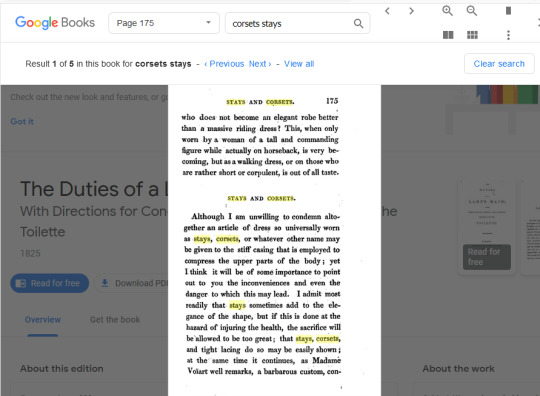
The Duties of a Lady's Maid: With Directions for Conduct, and Numerous Receipts for the Toilette (1825)

English Patents of Inventions, Specifications, 1865, 3186 - 3265 (1866)
----
What’s more, it’s not until very recently that people began treating stays and corsets as altogether different things. Gone with the Wind, the book? The terms corsets and stays are used interchangeably. The Oxford English dictionary? Describes stays as a sort of corset. The longest-lasting site dedicated to corsets on the internet calls itself the Long Island Staylace Association, with no indication that doing so represented an inaccuracy on its part. Sure, Elizabeth Swann should have properly said “You like pain? Try wearing stays”—at least it one wanted to be more accurate (if not good: good writing is partly about making oneself understood). But speaking here, and now, looking backwards? Very few people are trying to be that precise.
Additionally, it’s worth noting that corsets have had a variety of styles and features throughout history, and the term is by no means exclusive to what we most often see as corsets. The S-shaped corsets from the Edwardian era are very different from Victorian corsets, as are the more girdle-like garments that followed. While not everything is a corset, I’ve yet to see a convincing argument that the term isn’t broad enough to include 18th-century stays.
Tightlacing, Part 1: “Almost nobody did it”


Statements about tightlacing annoy me more than most, largely because they involve clearer instances of wrongness, but also because they hit closer to home.
Tightlacing has always been an imprecisely defined term: Lucy Williams, one of the best-known contemporary champions of corsetry, talks a little bit about the various ways the term has been used in her post “Waist Training vs Tight Lacing – what’s the difference?” found on her site. Usually, it refers to a quantitative measure—your corset must reduce X amount to be considered tightlacing—although recently, the discourse appears to have adopted a more qualitative definition, applicable to any instance where someone is shown displaying discomfort at being laced into corsets, regardless of how tightly they are (or aren’t) being cinched.

(Left: Moi, wearing a custom corset from The Bad Button Corsetry; Right, Upper: Scene from Bridgerton; Right, Lower: Scene from Enola Holmes)
----
Take, for example, the scene that has most recently caused a stir, from Bridgerton, where the character Prudence Featherington is seen grimacing as she is laced into her corset stays corset, while her sisters wince in sympathy and their mother, Portia, insists that she be laced tighter. Others have raised objections to this scene, focusing mainly on the fact that Portia’s mania for a smaller waist is anachronistic and makes little sense given fashions that de-emphasize the waist, but fewer have noted that for all the hemming and hawing that is being done by the characters, Prudence’s figure is ultimately not all that compressed, and seems perfectly in line with everybody else’s. Is what is been done to her tightlacing? A lot of people appear to think so! And yet, that assertion carries some implications. If Prudence is being forced to tightlace here, is everyone else with a comparable silhouette (again, pretty much everyone) also tightlacing? The answer is kind of important, especially if one also wants to claim that tightlacing was rare.
It’s worth noting that Valerie Steele’s The Corset: A Cultural History, one of the seminal works on corsetry throughout history, doesn’t actually attempt to make a case for the rarity of tightlacing. What it does attempt is to determine the accuracy of claims that women regularly laced down to 18 inches, 16 inches, or even smaller measurements, which is not quite the same thing. When exploring the question by looking at collections of surviving corsets from the era, the book has this to say: "Statistics from the Symington Collection [...] indicate that out of 197 corsets, only one measured 18 inches. Another 11 (five per cent of the collection) were 19 inches. Most were 20 to 26 inches.” While Steele readily admits this is hardly conclusive evidence, she took it as a sign that women with 16-inch waists were nowhere near as common as accounts suggested they were. Case closed, asked and answered, no one tightlaced, right?
Well, no.
Again, it comes down to definitions. Even speaking quantitatively, very few people define tightlacing as “lacing down to nineteen inches or fewer” (certainly no woman in Bridgerton is that tightly laced). The consensus, rather, is that tightlacing is not about the size of the corseted waist, but about the size of the reduction. How much people cinched, however, cannot be determined by looking only at corsets, because doing so requires not only those corsets’ measurements (and even those don’t tell the whole story, given that they don’t necessarily indicate how tightly they were worn) but also the starting measurements of the people wearing them.
In other words, say someone with a 33-inch waist uses corsets to reduce their waist measurement to 25 inches. This, according to most definitions, would be considered tightlacing—a 24% reduction!—and yet the absolute measurements would be nothing to write home about. How is that reflected in Steele’s sample of corsets? Impossible to say. A 25-inch corset could also be worn by someone with a natural 27-inch waist.
What, then, can we say about the frequency of tightlacing? Well, if we’re talking about dramatic reductions of, say, more than four inches (a two-inch reduction, by the way, can look like this—again, more dramatic than what we see in Bridgerton) one can say, with a fair level of confidence, that it was probably not the norm. And yet, “not the norm” is itself a very broad category, and given the numbers involved, “a minority of people” can easily still be “loads and loads of people”, as seen, for example, with COVID-19. Even if two percent of the population who wore corsets tightlaced, that’s still hundreds of thousands of people—hardly “almost no one”, as some argue. And if wearing corsets as seen in Enola Holmes or Bridgerton counts as tightlacing, the number becomes even higher.
Tightlacing, Part 2: “Tightlacing is bad”


Perhaps not coincidentally, another element of the current corset discourse involves taking all the baggage usually assigned to corsetry in general and applying it to tightlacing instead. Corsets are not painful, goes the argument, but tightlacing is. Corsets are not unhealthy, but tightlacing is. People could do everyday things in corsets, they’ll say, but not when tightlaced. Arguments made against corsets in the 19th century were slander made by people who just hated women (another half-truth I have little time for), but are apparently utterly unobjectionable when applied to tightlacing. This, as many modern-day tightlacers will tell you, is bullshit, but it feels like an especially odd argument to make in light of everything else.
As in, what is the point? It feels a lot like saying “I’m not sex-negative, but having sex with more than X partners is icky.” And given the history-focused slant of the current discourse, it’s safe to believe that most people arguing against tightlacing are not people who have attempted it. There is, however, an existing community that will happily tell you, based on personal experience, what tightlacing is actually like.
So from personal experience: tightlacing may not be like wearing a bra, and there are definitely some considerations that you have to take while doing it— getting dressed, sitting down, and eating are all done differently when tightly laced—but this is more logistical than anything, and also applies to other things—running in steel-toed boots is much different from running in sneakers, and the advice when doing the former is often “don’t”. Additionally, the margin for error decreases the more tightly laced one is, but corsets aren’t special in that regard: proper care is much more important when one is flying a commercial jet than when one is flying a one-seater. But yes, you can do physical activity while tightlaced. Not necessarily the sort that you could do in exercise clothes, but then, the fact that suits are not optimized for running doesn’t make suits bad.
Tightlacing, in the end, is not really different from wearing a corset. Some people will like it, some will not, but ultimately, how pleasurable or how unpleasurable it is (it’s very pleasurable, in my book) depends on what you put into it, and that’s something quite a few people—not a majority, but also not “almost nobody”—who are often far more tightly laced than people in movies, would attest to, if people listened.
114 notes
·
View notes
Text
Historical Inaccuracy, Set Dressings, & Plot Devices
I don’t think I ever hide how much I love historical costuming and how I try to keep educated and up to date on all the details and research. I’ve had friends ask me questions when it comes to the fashions of the era they’re basing their wips on and I’m always very happy to help but I want to be clear.
Historical Inaccuracy does not equal bad. I tend to think about the first Pirates of the Caribbean in this case and how I was talking to someone and then asked my if the clothing in the movie was accurate and my mind always goes to that scene where we meet Elizabeth and she’s talking about corsets and how women in London must “not like breathing” when 1. They’re stays and 2. Elizabeth herself would have likely been wearing them since she was twelve. That’s not to say Pirates of the Caribbean isn’t a nostalgic fav of mine or I can’t credit it for helping to get me obsessed with pirates as a child or that scenes like that make me angry. In fact, Elizabeth’s unfamiliarity with stays works as a plot device later as she wouldn’t have fainted and fallen into the water if she’d actually been used to them/hadn’t been tight-laced and the exaggeration of not being able to breath for the extremes of fashion is more for the audience to later be able to accept this.
Long story short, I don’t actually go scouring through fiction to be angry about historically inaccurate fashion in stories that aren’t trying to match up to history in the first place. I think my point of wanting to be educated on historical fashion did start because of all the misconceptions and a genuine interest, and also because sometimes it’s nice to excuse my characters from my own modern sensibilities. There’s plenty of makeup trends, hairstyles, silhouettes, that I find very unattractive that’s present in historical fashion but I like using them because I like what they do for a setting and what they can tell readers about the characters so at the very least I do think reading a little bit about historical fashion is good to spark world building inspiration even if you don’t want to have a complete copy and paste of the reality in the same way I like complete exaggerations of history to have some basis in what is known. It’s also important to know that there are no absolutes in historical accuracy vs inaccuracy either. I can bemoan all day about corsetry and modern discourse and the misunderstanding of the garment but there were real people who didn’t like wearing them and didn’t wear them or were critical of them back in their heyday (Lousia May Alcott, author of Little Women a very famous voice of the anti-corset club) there are always going to be examples of a mainstream fashion culture but also alternatives but I’m always gonna be more interested in settings that ground their break from the mainstream in things that don’t immediately appeal to me as someone in the 21st century but stands as a form of rebellion that is more grounded in the setting than what the writer things their contemporaries will find cool.
I must sound very judgey at this point but I don’t really care I’m fully team complete avoidance of historical-esque aesthetics because people might find them ugly is silly to me because that’s about to be all modern characters in like 10 years. I’d much rather have my characters fit the aesthetics of their period whether or not I’m adhering to rules I made up or stole from a real era vs trying to match them up perfectly with current 21st century trends in the hopes readers will find them fuckable.
But the gist is really to choose what��s best for a setting and for a cast of characters or for the general tone of the story because historical accuracy doesn’t make or break a piece (unless that’s what it was going for and it failed miserably) and historical fashion isn’t even as strict or without leeway as many think.
#june trash#just having some thoughts this morning while I can't go back to sleep#I feel like I've been spending this month trying to sweep up my potential reputation#idk I just don't want to seem like the guy who hates everything#I'm picky sure and easily annoyed by things I don't like in fiction but I hope no one thinks I throw books at the wall if they're 'wrong'#except once#but that was only because the character was supposed to actually live in a historical time period and it felt like the author hadn't done#any research#either into the garments or into the dress of working class women#so I was a bit on edge ngl but I mean in terms of fantasy especially and in secondary worlds I'm not gonna scream at you#I just want more worlds to have some sort of fashion 'rules' y'know#I feel like for a while we were in an era where all fashion characters wore vague jerkins and those prom like runway dresses#and so there wasn't really any form of cultural or societal trends because everyone was just picking pretty#dresses or whatever was trendy and in season with no lines or barriers for what people of different means wore#and I will say that kind of world building I do not like I might not put the book down but I'll shame the characters' style#that's just my 2 cents#people will be shocked to hear I actually don't describe clothing all that much in my own work#I'm sure when I write posts like these it must seem like every character intro comes with like a paragraph of what they're wearing#I promise I don't do that
20 notes
·
View notes
Text
Headcanons on Russia’s and Prussia’s relationship with France.
Russia:
I think that in the XVIII century a large chunk of Europe had a crush on France. French culture was widespread among European courts and the language was being used to communicate in a similar manner English is used today. Frenchness was just very IN at that time.
Those countries included Russia. At that time Peter the Great was westernizing his country, and injecting French-ness into Russian lives was a part of this process - Versailles and the French court impressed Peter immensely when he went to visit France and when he came back home, he began emulating many things he observed in the western country. Language, customs, widespread mirrors everywhere, architecture, gardens. You name it.
High-born Russians would talk to each other in French and give themselves French names. Lets note that French wasn’t the only foreign language that was widespread in Russia, so were others, like German and Latin [mostly used by the academia.
“(...) of all the languages which began to have currency in eighteenth-century Russia, it was French that acquired the greatest social, cultural, and political significance,even if it was not always so widely spoken as German“.
The two next generations of Russians grew up within this Francophile culture and viewed it as something natural, from their perspective it was no longer an exotic fashion, just the way thing always were. Therefore, this was something more than just a fleeting fascination that lasted as long as Peter ruled - and had lingering influence on Russian culture.
“The most important stimulus for the development of French-speaking in Russia, though, was the use of French as a court language from around the middle of the reign of Peter’s daughter Elizabeth (1741–61), who had learnt it in childhood from a French lady at her father’s court.“
And so it went on from there: “At the beginning of the nineteenth century, the Russian nobility still preferred French to Russian for everyday use, and were familiar with French authors such as Jean de la Fontaine, George Sand (etc.). The influence of France was equally strong in the area of social and political ideas. Catherine II's interest in the writings of the (french) philosophers of the Enlightenment (...) contributed to the spread of their ideas in Russia during the eighteenth century.” and “ During the nineteenth century, travel in France was considered a form of cultural and intellectual apprenticeship. “.
(source) So the interest in French ideas and culture was strong in the second half of the XVIII century and in the XIX century.
So in other words, Russia had a crush on France - it was a total puppy love mostly based on superficial things, like aesthetic, nice smells and pretty, elegant European opulence but most of all: France was the ideal of what Russia was trying to become, the epicenter of European-ness, the “civilization” and Ivan was in the middle of this lowkey cultural revolution in which he was trying to re-invent himself as a modern, “European” country. So I think this crush was very much one of those "I wanna BE YOU" types of crushes, he was head over heels for what France represented - that’s why this hit so hard.
There was some more personal stuff there too, like France's eloquence, his literature and philosophy. Enter a lot of perfumed love letters! Even when the crush slowly withered away Russia still felt - and feels - strong admiration for France and honestly enjoys his culture a lot.
France himself enjoyed the crush but wasn't really that interested in reciprocating - as mentioned above, large chunk of Europe was also crushing on him due to his culture just being in fashion, so it's not like Russia himself was standing out. But they did become friends and still have good personal relations with each other. They have a lot of passions in common, such as ballet, art, music, opera, Romanticism etc, so they still enjoy talking about this stuff together. It’s not a Deep friendship where they trust each other, don’t be fooled, they don’t trust one another at all! But they do like hanging out.
I also HC that the way both French and German were important in XVIII century Russia (as cited above: French with greater cultural significance and German more widespread) is representative of him catching feelings for both France and Prussia at this time, tho one of those wasn't just a crush.
Prussia:
My non-canon-approved hot take here is that I don't think him and France were ever friends. The exact opposite of that even.
It's true that Frederick the Great also had this hard-on for the French, and in effect Prussia speaks and writes excellent French. But after Frederick William II took over the throne, he took back all those Francophile preferences and began promoting German literature and language instead - something the educated classes of Prussia were thankful for. So because Russia shared his ruler's fascination with France his interest outlasted Peter the Great and became a more prevalent part of Russian culture for a long time, while Prussia never shared Fredrick’s fascination and therefore it got overturned as soon as the new king sat on the throne.
And that makes sense, bc in general Germans and French weren't very friendly with each other during their history. German- French enmity, also called the hereditary enmity, is an idea introduced in the XIX century, and it states that those two forces are natural enemies due to their inherently different goals and incompatible interests. Due tho this they keep bumping against each other throughout the ages. You can see echos of this sentiment it in the Napoleonic Wars, Franco-Prussian War, WW1, the Treaty of Versailles, WW2 etc. France was also the country that stood in the strongest opposition to the German Empire being created, so a big issue for Prussia.
It’s important to mention that this German-French enmity was often used as a propaganda tool for wars and simplified the complex relations between those two groups. Of course it did, even Austrian/Prussian relations weren’t ALWAYS bad, even tho they were called ‘the biggest enemies’ by historians.
It is believed that the enmity ended after WW2 and no longer is a thing. To me that is a pretty great example of Germany taking over the reign and replacing Prussia. Prussian/France relations were bad, but German/France relations are pretty darn good. And it makes sense, because Prussia had different goals than Germany has, and they are very different individuals. I see France and Germany as friends due to their shared work in UE, tho I’m not sure if they would be something more than just work friends.
Anyway, this is Hetalia and not a historical-political deep dive - to me what counts in Hedcanon context is the general feel throughout history: were they generally allies or enemies? Were their interests clashing with one another or were they compatible, most of the time at least? The whole idea behind this “inherited” enmity is that French and German interests were incompatible, so it had to end with a conflict. And they did, many times over. I feel like the importance of the Napoleonic wars especially is often undervalued here - it was a HUGE conflict that would have a lasting impact on their relations, way bigger than the Wars for Austrian Succession, which are often cited as proof of their friendship. But they were an outlier in general Prussian/French relations.
That’s why I think Prussia and France are not, nor ever were friends, they view each other as enemies and dislike each other. Tho during the reign of Old Fritz their relationship was warmer and more amicable than during other periods, considering they actually had similar goals and fought together for a change - mostly because that was convenient for then, not due to some preexisting friendship. But I do like the idea that during this time they had some kind of difficult comradery going for a brief while and there was this fleeting “maybe in another reality we could be friends” vibe.
Due to the bad history, Prussia's dislikes of France can be seen in many small things that irritate him, like he just detests Francis' need to show opulence, his over-the-top rococo aesthetic and cuture-esque fashion sense, hight emotionality drives him bonkers and even the pastel flowery color palettes he often wears irk him. And don’t even get his started on the Revolutions! He’ll talk your ear off.
Tl’Dr: So Prussia and France don't like each other and are generally bitchy and passive-aggressive with one another. Russia and France are friendly and good acquaintances, while not exactly close. Russia just likes him - he still admires a lot of things about French culture, enjoys the language, cuisine, architecture, fashion etc, and used to have a crush on him.
Rusprus take:
Prussia in a confident, self-assured person, but when it comes to France, he can be surprisingly self-conscious. He still remembers that crush Russia used to have on him and WHY he had it - because of many characteristics that France possesses, but Prussia doesn't. Like being romantic and sentimental, sensitive, emotionaly open, appreciative of beauty, artsy etc. Sometimes Russia finds that cute and endearing, bc it makes him feel wanted, but sometimes it's just... ridiculous.
APH Prussia: What do you wanna watch tonight, Vanka?
APH Russia: Hm... maybe that movie, Marie Antoinette?
APH Prussia: Ugh OF COURSE you wanna ogle HIM!
APH Russia: W... what.
APH Prussia: France! You wanna ogle that cheese-smelling frog-eater!
APH Russia: What... no! Gilya, Gilyushka, Gilynechka! That's absurd, I just want to watch a pretty period drama!
APH Prussia: Don’t you “Gilynechka“ me! And as if that's not enough...
APH Prussia: She was AUSTRIAN
APH Russia: Omg. Kill me now.
When you have almost 1000 years of history together then even picking a Netflix show can be a minefield!
Anyway, they end up watching the movie but Prussia roasts everything in frame :D
#aph prussia#aph russia#aph france#hetalia#hws france#hws prussia#hws russia#ruspru#axis powers hetalia#hetalia world series#hetalia headcanons#historical hetalia#ivan braginsky#francis bonnefoy#gilbert beilschmidt#rusprus#rusfra#I feel like those HCs are getting longer and more ranty#and probably more boring#sorry for that!#I honestly dont know why it just gets out of hand#still hope at least one person enjoys them#if so its work it! :)#queque
79 notes
·
View notes
Note
Hello! I had an idea for an imagine that I wanted to get your thoughts on, if that's fine by you. Which Characters from The Hobbit and Lotr do you think would most enjoy dating a Dark Academia-style Writer? So like she dresses in the Dark Academia fashion, reads Classical Literature and her own stories and essays to them while cuddling, excitedly Rants about History and Literature to them, and maybe they even find her journal full of sappy love poems and rambles about how much she loves them? Who do you think would be most down for a s/o like that, if you don't mind me asking. I'd love to get your thoughts on this, and your blog is so spectacular btw!
Oh ho ho, my friend, this is right up my alley. I am obsessed with Dark Academia.
For ‘The Hobbit’:
Bilbo Baggins.
He was literally the first person to pop into my head. He is a perfect mix of cottage core and light academia, and I feel like he would have a lot of love for dark academia as well. When you’d cuddle, you’d both be reading your respective books (or even better, reading the same book with one another, or even even better, reading aloud to one another), and when a particularly deep or meaningful quote or scene happens, you would both discuss it thoroughly. You would both go into rants about history and literature you find interesting, and understand one another perfectly, going into incredible depth about the topics. If he ever found love poems you wrote about him, he would read them with the fondest smile upon his face. Who knows, in a few days, you might even come across a few poems or songs he has written about you.
Bard.
Bard has a lot of respect for history, (I hold firm to the belief that he was one of the very few lake men who really cared about the towns past), and would probably even help teach you some history of Dale and Esgaroth. And if you teach him about our worlds history and mythology, he would be all ears and find it utterly fascinating. He would totally be down to just spending quiet days at the library with you, and would probably read every book you recommend to him (Imagine discussing ‘A Secret History’ with him… that would be quite an interesting conversation). And if he ever came across love rants/poems… this man would get all cute and tell you how much they mean to him. He’s just that kind of person.
Thorin.
This dwarf would be incredibly into Dark Academia. I can just imagine dressing him up in one of those gray waistcoats with the white, long-sleeved undershirt. If he should roll the sleeves up to the elbow… sigh. He could totally dress the part. And he would absolutely love seeing you dressed dark academia style. His color palate is very similar to what is typically dark academia. And get ready for hours of discussing both dwarrow and human history with him. Also, if I may go out on a limb here, there is this headcannon I have about dwarrow museums being carved into old mineshaft used of resources. Thorin would be immensely proud and excited to show you and teach you everything in the museums. Walking down the stone halls and him pointing out various carvings and texts on the walls, your dark academia mind couldn’t be happier. And cuddles with his arm around your shoulders, lying in bed after a long day, ending the night reading. He would occasionally look down at what your reading (possibly asking what’s going on in the plot, depending on if you get annoyed by interruptions or not) and smile to himself. If you read your own work to this dwarf, expect the best feedback possible. He is very thorough with his feedback, and knows how to properly give constructive criticism as well as highlighting the best parts of your work.
Lindir.
This sweet little elf would be beside himself. He loves the libraries in Rivendell, and you sharing and reading stories with him opens up worlds. He would also love the way you dress, and will often ask what has inspired your ‘look’ for the day. He gets excited when you come to him with a new topic to rant about, and will likely contribute some very insightful views on the matter. When you come to him with questions about Middle Earth’s history, he will gladly answer whatever you ask (and probably end up having a history rant of his own. ‘Hey Lindir, what are the Silmarils?’ ‘…how about you sit down, and we’ll chat about it for a few months.’). He would just be the sweetest if he found your love rambles, and would be blushing the entire time reading them. Expect a wonderful thank you and an entire sonnet of his own composed for you.
Ori.
Can’t forget this little scribe. He would be beside himself at finding a fellow reader and writer, and the two of you would have so many reading sessions where you discuss what exactly this word meant in this context, or just ranting sessions where you gush and/or vent about a certain scene or plot development. He would find your outfits absolutely exquisite and probably even help you piece some together. Cuddling with him while reading is honestly the best, because you’ll just be laying side-by-side, surrounded by pillows and blankets (possibly in front of a fireplace in the Great Erebor Library), and just be reading your different books together, content to just read without feeling the need to talk. If you ever read your work to him, he would be beside himself at the level of trust you place in him (being a writer, he knows how daunting sharing your work can be), and he would love whatever you write. Expect him to start sharing his work as well. For the love poems, You’ll probably find his poems/rambles first, tbh. He just loves expressing himself through writing, and expressing his love for you is his favorite thing. You both get all sappy and blushy when you read one another declarations of love.
For ‘Lord of the Rings’:
Frodo Baggins.
Much like his Uncle, Frodo has a healthy appreciation for history and literature. He’d just love pouring over different books with you, and discussing them. His favorite thing to do with you on rainy days is to curl up with a good book and read aloud. Maybe even a walk down the trails and paths with an umbrella as well (Lobelia in the hobbit movies and the end of return of the king has proven there to be umbrella’s in Middle Earth). Hobbits are known for their passion for History, particularly family History, so he’ll definitely go into some rants of his own about the history of the Shire, and will sit and listen to your rants as well.
Elrond.
Lord Elrond is like a living, breathing, history textbook. He would be the absolute best person to discuss historical events and mythology and such. His keenness for knowledge knows no limits. There will definitely be very, very, long conversations about literature and meanings behind what the author writes, and the morals and values of the texts. Honestly, there is just such a depth of understanding between you and Elrond that is incredibly hard to find in others.
Faramir.
This man. This is the man who literally fanboyed over Gandalf and became a pupil to him. He would absolutely be beside himself when he meets you, because another human who is obsessed with learning and history and literature and discussing it and having deep conversations about it??? He would fall hard. And he would always love the way you dress, whether you are wearing a cozy sweater-vest or a dramatic trench coat. The two of you would literally spend hours in Gondor’s libraries, pouring over shelves of scrolls and books, taking notes on them, and maybe with a few older ones, restoring them together. Your favorite thing to do before going to bed is lighting a few candles and reading together. He would especially be fascinated and amazed at anything you have written and willing to share with him. He honestly just loves you so much, and feels so understood when he’s around you. And finding love poems written about him fills him with an indescribable amount of joy.
Aragorn.
When not off doing important Ranger or Kingly duties, Aragorn would just love to spend time reading with you. The kind of quality time where neither person needs to say anything, because the simple presence of the person is enough. He’s very into History, and I can totally see him ranting to you about the story of Beren and Luthien (perhaps the rest of the Silmarillion if he has the time), and would love to hear about your stories and books from our world. He’s the kind of person who prefers to dress practical, but that doesn’t stop him from complimenting your outfits and thinking how great you look every time you walk into the room. He loves the aesthetic of it. And should he ever stumble across a poem about him, he will probably keep it to himself, but memorize every word and repeat it to himself while traveling.
So I may have gotten just a tad bit carried away with this, but it was so much fun doing! Thank you for this ask! I hope this is what you were looking for. Now, i’m going to make myself a cup of tea and go to bed.
#bilbo baggins#dark acadamia#ori#aragorn#lindir#elrond#faramir#hobbit asks#lotr asks#frodo#thorin#bard#claraofthepen#the hobbit#lord of the rings
44 notes
·
View notes
Text
Fashion's Relation to History

Just as fashion allows for personal self expression, it also represents the cultural and societal context of a time period. Silhouette, color, material, sex appeal, and accessorization can all reflect major moments and themes in history such as social movements, conflict, and wealth.
1910′s
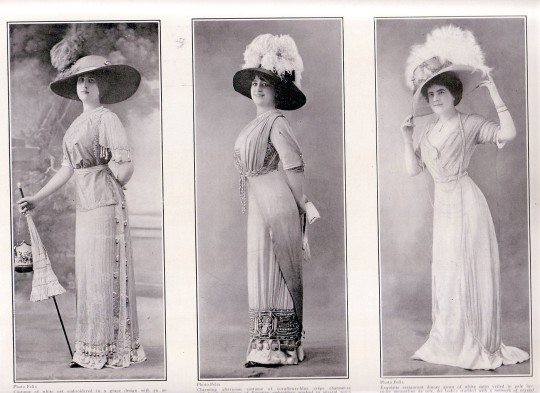
In the 1910′s fashion began to be less restrictive as tight corsets and layers of crinoline were left in the 1900′s. Influential designer Paul Poirot made clothing that allowed women to dress themselves, as buttoning and tightening intricate corsets often required the help of more than one person. This made clothing straighter and less detailed than it had been in previous years. Turbans, pantaloons, and kaftans were popularized in this era. With the start of Word War I, clothing was simplified in efforts to cut costs. Dark colors and simple silhouettes became popular in the late 1910′s due to the affordability of the style.
1920′s
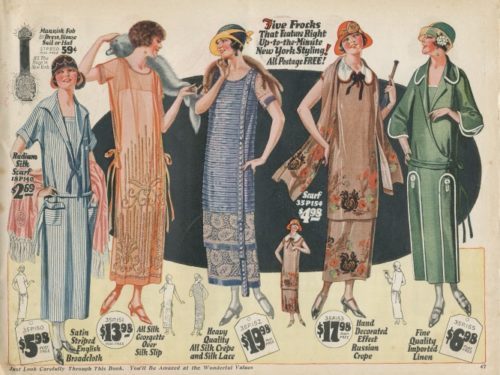
Now, if you don’t know what fashion was like in the 1920′s... where have you been? As women gained more Independence and joined the work force, women's fashion took on a more androgynous look with straight, dropped waistlines and simple shift dresses. With a prosperous economy and an emphasis on pop culture and consumerism, intricate designs and simple short dresses began to marry together. Party dresses maintained their boyish structure but with added bedazzling. These dresses were made of intricate fabrics featuring geometric shapes and lots of beading (summed up in the ever popular Art Deco aesthetic). Coco Chanel was the leading designer of the time and popularized the term “little black dress.” 1920′s fashion had many sides to it and was heavily influenced by many societal factors, showing how fashion represents the historical context of its era.
1930′s

The 1930′s are often refereed to as the “Golden Age of Glamour.” Feminine silhouettes made a reappearance as movie stars acted as fashion icons of the era. Sophisticated evening dresses worn by these movie stars were idolized and sought after. Though femininity and glamour was popular with the upper class, the stock market crash caused a demand for affordable fashion, furthering the ready to wear market. Trousers and athletic wear in particular started gaining popularity.
1940′s
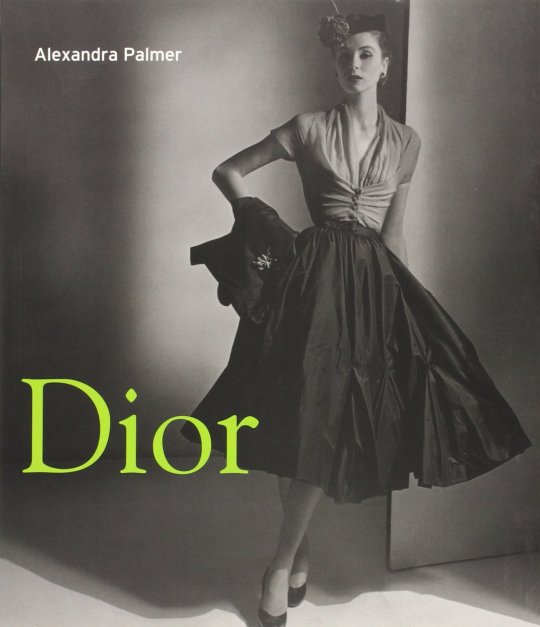
Though 1940′s fashion is not talked about much in pop culture, it was a revolutionary era. People sought affordable options after the end of World War II, so the ready to wear and manufactured markets boomed. Many High fashion and Couture designers closed their stores as many could not no longer afford hand crafted clothing. Nylon and polyester was invented, replacing expensive silks to create cheaper clothes. Many women adopted a masculine style as they entered the work force, but towards the end of the era the pre-war feminine style came back with a pow. This resurgence of corseted waistlines and structured gowns came from Christian Dior’s 1947 collection. Dior would continue to influence fashion trends for years to come.
1950′s

The 1950′s was the era of the icons. James Dean, Marilyn Monroe, Sophia Loren, and Grace Kelley were idolized by the masses and popularized many styles of clothing. For men, blue jeans and leather jackets became all the rage. This era also saw a refinement in women's clothing. Women were expected to be proper stay at home mothers, looking perfect while they did chores and cared for their children. Peter pan collars, solid colors, pearl necklaces and simple silhouettes were popular in this era.
1960′s
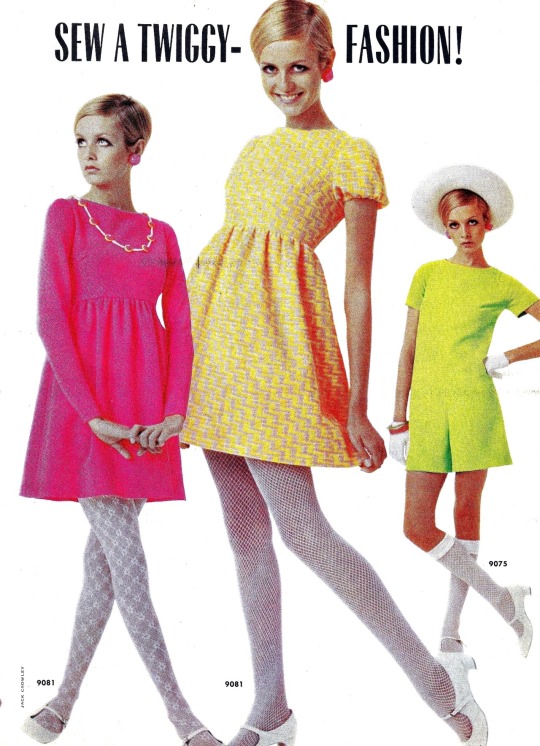
Careful, the transition from 1950′s to 1960′s fashion may give you whiplash. Towards the middle of the 1960′s Mod fashion made its way from the UK to America. Popularized by the model Twiggy, the style consisted of bright colors and very short hemlines. Dresses were straight and boyish and pants were tight and high waisted. Graphic makeup was also popularized by twiggy and her signature eyeliner lashes. On the other side of the 60′s there was a rise in elegant fashion due to First Lady Jacqueline Kennedy. Her style was reminiscent of the simple silhouettes of the 50′s with added accessories and her signature pillbox hat.
1970′s
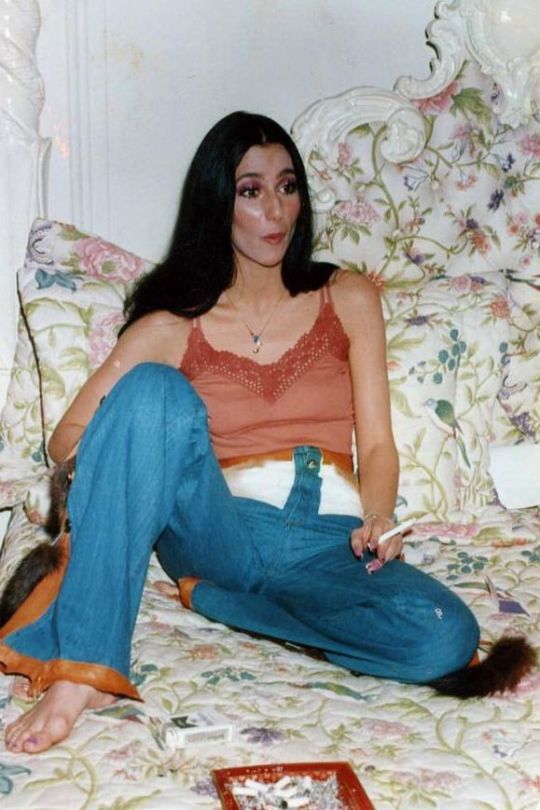
What wasn’t popular in the 70′s? This era saw the emergence of major subcultures, like disco, hippy, glamour, and punk. The hippy style was very widespread, consisting of tie dye, bell bottom jeans, kaftans, and halter tops. This style was especially popular in the anti war counterculture brought on by the USA’s involvement with the Vietnam war. The style wasn’t adopted by everyone, however. A new wave of punk fashion was lead by Vivienne Westwood. Platform heals and sequence was popular with those interested in glamour and disco. The era also saw a vibrant style among African Americans during the uprising of Motown, soul, and reggae music. Natural hair was worn by many to counter the pin straight hair preferred by white people at the time. This summary doesn’t come even close to covering everything about 70′s fashion. It truly was a time where fashion represented the social and political context of an era.
1980′s

The clothing of the 1980′s often elicits of two reactions: passionate adoration or complete disgust. Everything was exaggerated during this time: prints, shoulder pads, accessories, hair. Sportswear became popular as brands like Adidas and Nike opened. Women often wore power suites to work. The subcultures of the 70′s were popularized by icons of the era. Madonna carried the 70′s punk movement into the 80′s, featuring clothing like studded jackets and combat boots. Hip hop was popular during this time with baggy clothing and loud colors. Fashion was highly influenced by the stars of the era such as Madonna, Boy George and Michael Jackson.
1990′s

Wait one second... I have to pull up my 90′s Pintrest board for this one. Fashion in the 90′s depends on who you ask; Ask Micheal Kors and he’ll say that everything was simplistic and easy; Ask Dolce & Gabana and they'll say it was sexy and bedazzled; Ask Channel and they’ll say it was crisp and elegant; Ask Versace and he’ll say it was fun and loud. Among the public a simple, over sized aesthetic was favored. Plaid sets were popular (a la Clueless) and globalization lead to fashion influences from different areas of the world. Subcultures from the 70′s and 80′s continued to adopt their own forms of fashion. Though supermodels existed before the 90′s, the era marked the beginning of their idolization. Tyra Banks, Linda Evangelista, Naomi Campbell, Cindy Crawford and Christy Turlington are a few of such models you will spot if you look back on any major fashion show from the 90′s. Kate Moss, another model from the era, popularized the Heroin Chic movement. This movement... well it’s in the name. Women just liked to look like they were on heroin. Worryingly skinny frames and heavy eye bags became all the craze with models. I better move on before i make this summary 10,000 words long... It was just such a great era for fashion!
2000′s
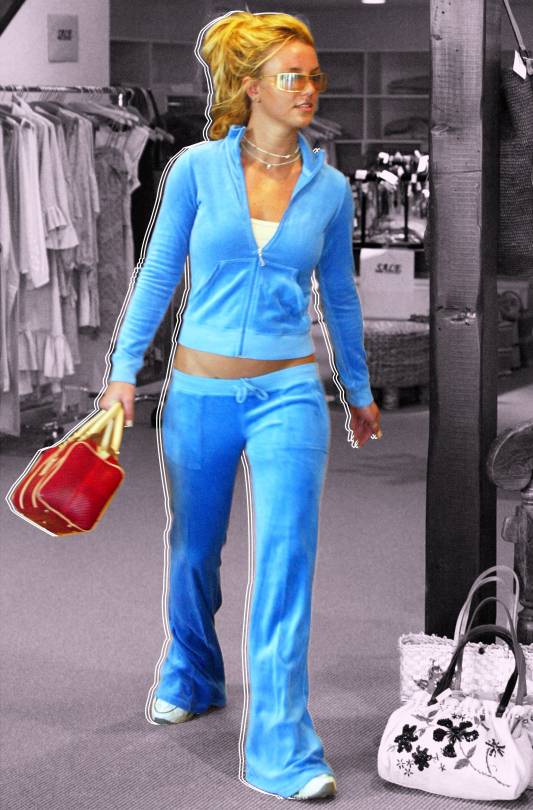
Similar to 80′s fashion, clothing from the 2000′s are either loved or hated. Comfort and streatwear was the driving factor of fashion. Juicy Couture was responsible for the ever popular velour tracksuits many wore during the era. Dangerously low rise jeans, feathered hair, trucker hats, and layering was all popular during the 2000′s. Stars like Gwen Stefanie and Britney Spears lead the ever evolving fashion trends of the era.

In conclusion, Fashion changes rapidly. It takes inspiration from itself, it has leaders who push it onward, and it represents whatever history is being made at any given point in time. It is more than a piece of clothing, it’s a snapshot in time that can be interpreted in so many different ways. No matter what is going on in an era, people find ways to express themselves through fashion.
27 notes
·
View notes
Text

I find the intersections of cultures interesting, specifically the intersections of cultures we are born into and the cultures in which we choose to participate. These chosen cultures may speak to us on many levels, be they emotional, intellectual or even subconscious. We may not know why we are drawn to something but we feel an innate pull to be involved. The free will of humans leads to the most interesting combinations of birth and chosen cultures, which furthers the breadth of manifested identities in the world. Because of my own life experience, I decided to investigate other people of color who choose to be artists and identify as alternative, goth or punk.
During this project I had the privilege to meet, photograph and interview some stellar human beings. People who are unafraid and unapologetic about their artistic choices in this world. I am so inspired by each and every one of you. Thank you for being you and giving me a glimpse into your world.
Ashley - “I just do what I think is fun!”
I met Ashley Norman at school, I remember the day well. She had on a really bright outfit and her makeup was weird and fun. She had drawn wispy lines around her eyes in white eyeliner, like an abstract Picasso portrait – each eye different than the other. I thought it was so unique and I was impressed by her call to push her style in a different direction than her peers. When I met back up with Ashley recently, I asked her, what was her inspiration and the pull to identify as an alternative artist? She said only this: “I just do what I think is fun!” Ashley said she is also inspired by her diverse background. For her, being Black, Korean and Dominican gives her much to pull from historically and artistically.
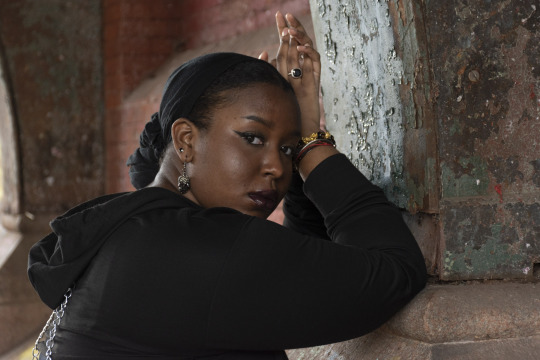
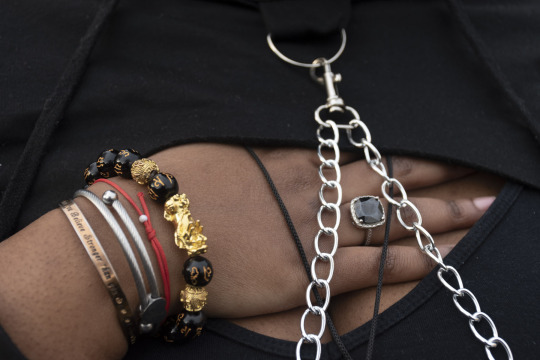
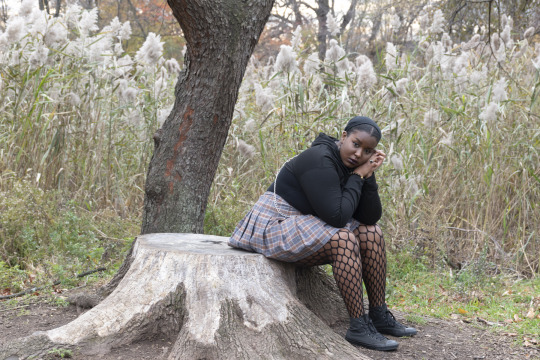

Selena - “I think the hardest part was me finding my tribe, my kindred spirits. You can’t always spot someone who is alternative all the time, just by looking at them. Sometimes it’s highly internalized and you would never know.”
Selena is an illustrator, whose artwork is centered around themes of alchemy and the occult. She expressed that her drawings of demon girls with detached limbs, reflected her inner feelings of being disconnected from her identity sometimes. I asked her when she started to identify as alternative and for her it was in middle school when she realized that music was so important to her but that she felt little connection to Rap and Hip Hop. “It’s kinda like, when you’re Black, you kinda assume that you’re supposed to like these things, and you kinda do, but…it doesn’t feel like it clicks. Whereas for me rock and alternative music clicked for me, I was more able to relate to the subjects in the songs. I was 14, rap music was not helping me cope with what I’m going through. With Rock, we are talking about anger, feelings, things I could better connect with. From there on out I wore all black and listened to My Chemical Romance.”



Roxas - “It’s totally 100% possible to thrive and be yourself.”
Roxas Timmons was my classmate at LaGuardia in the photo program. I remember the first day I saw them and thinking how committed they were to their style. As I got to know Roxas over the past two years, I have learned of their interesting origin story growing up in the conservative Midwest. Roxas likes to be fluid in their identity and although they mostly identify as goth, they also enjoy dressing as a clown, a ghost, punk, alternative and anything in between. They talked a lot about how music and fashion influences their photography, which is primarily driven by self-portraits. They recounted how they started dressing alternative little by little in high school and after graduating, fully went for it. “I meet a lot of people who always say to me ‘I wish I could dress like that’. I want people to know that they can. They can have a successful career and make their way in the world dressing like this.”

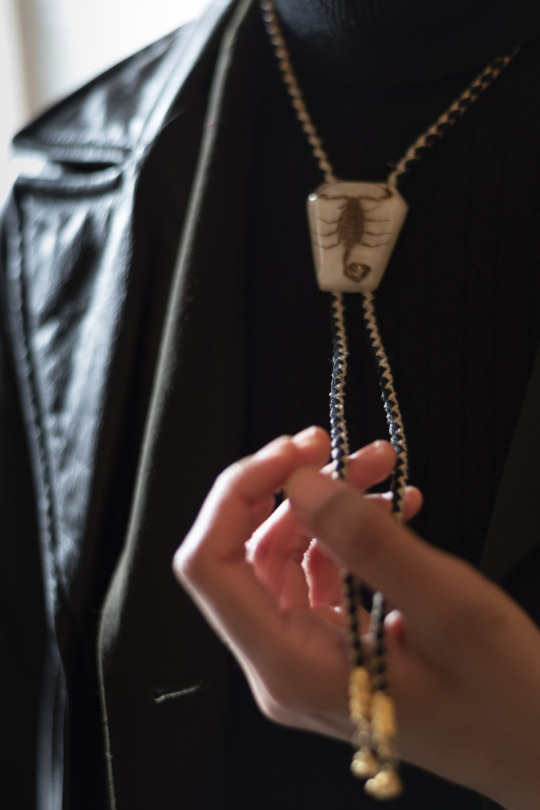
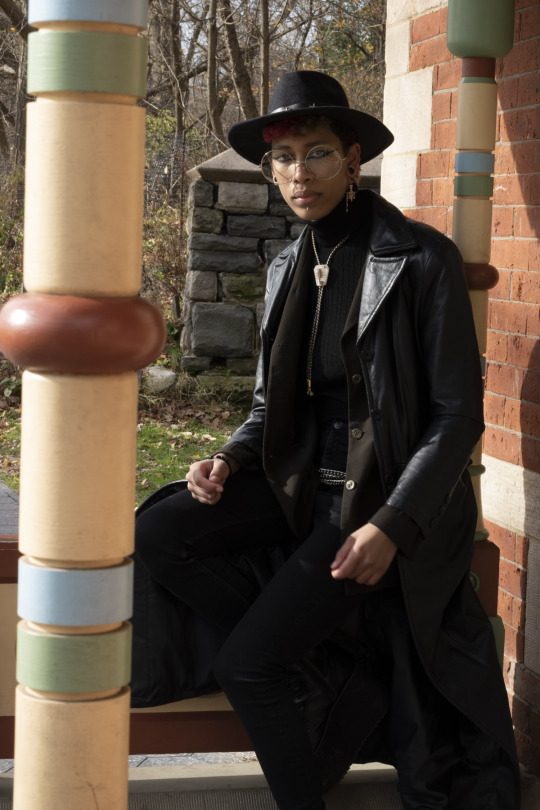

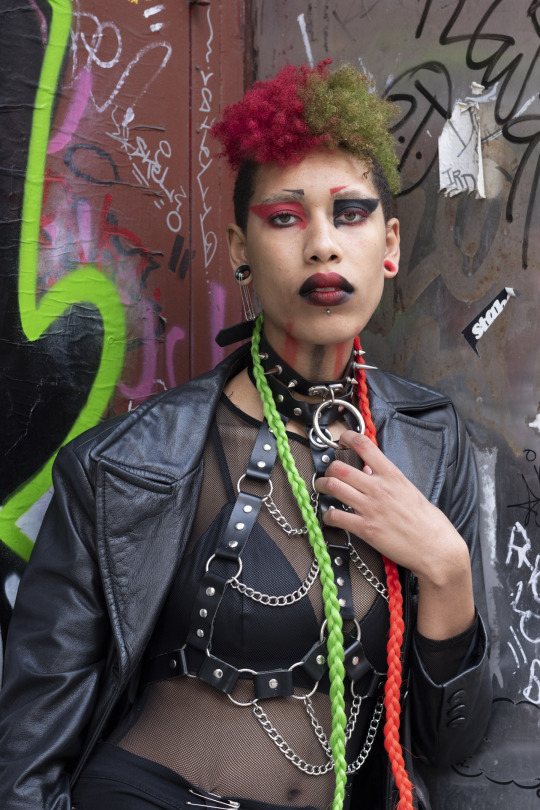
Jacqs - “The art that I give to the world is my self expression. Serving looks.“
Much like many of the people I interviewed for this project, Jacqueline Chavois is a total stranger to me. Stumbling across her Instagram account, I was immediately struck by her incredible style and the collections in her house, where she regularly photographs herself. I asked her about her split tongue and why she would choose to make such a drastic choice of body modification. “I feel like it connects me to my African ancestry because the body modifications – these painful rites of passage, I feel that my African ancestors were doing that. It annoys me when it’s seen as only a White thing. Definitely has indigenous, African, tribal roots.”

Shola - “The aesthetic I want to give off is to live that best version of myself and let it be reflected in the work that I do.”
Shola Aurora is a first generation Nigerian singer-songwriter, born and raised in New York City. He performs an hybrid of rock, metal, and industrial goth music. He is heavily influenced by Japanese culture, having traveled to Japan several times. Anime, video games and Japanese fashion are all major inspirations and play out in his artistic choices. I interviewed him in Saint Marks Place, an area where he was able to truly express himself as a young man growing into his identity. Shola talked about how he came to his own style by being exposed to Visual K, a Japanese branch of glam metal. “Visual K showed me that performing is more than just getting up there and singing a song, you can create a world or an experience. It inspired me to live the best version of myself that I could. It left my mind open in terms of what I was interested in doing. As someone who grew up in Brooklyn in the hood, as a black male, the idea of doing feminine things or wearing makeup is unheard of. It took a lot of personal growth for me to break through to that side of myself.”




Xero - “Everyone needs a little bit of fantasy.”
Xero Gravity is a 24 year old biracial Black/Jewish cosplayer and digital content creator who centers herself around diversity and inclusion in the horror and sci-fi realms. I asked her to speak about why these genres are so important to her. “I feel horror is the best lens through which to look at society’s fears as a whole. What people are scared of at a certain time says a lot about what people are going through. When you look at the history of horror, it doesn’t really look good for Black and Brown people like us. We have a very complicated history with the horror genre. I always bring the discussion of horror and Blackness back to Birth of a Nation, the first feature film. It features a white woman in ‘peril’ being hunted by a white man in blackface. Woodrow Wilson screened this in the White House and endorsed it as factually correct. At the end the ‘black man” is hunted down and killed by the KKK, putting the KKK in a favorable light. No one talks about how this is the scariest film ever if you’re a Black person.”
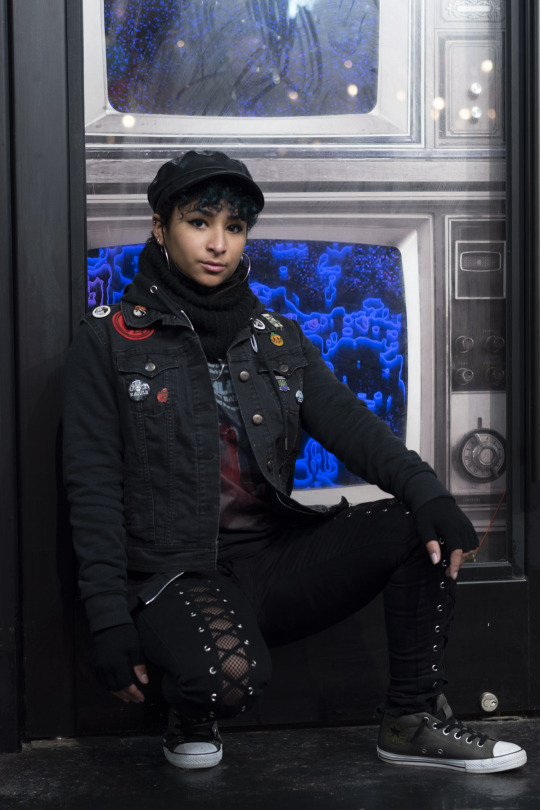



Uny - “My art is fashion. My art is clothes, my art is expression. The way I dress is a total expression of the way I view my world through my lens.”
Unyquee Loretta Ortiz is a seamstress and cosplayer who identifies as Black and Latinx. Born and raised in the Bronx, she spoke about how her heritage plays into her stylistic choices. “I often wear a lot of African prints because I want to be connected to Africa in the best way that I can do it. I was raised around my Latinx culture so I go out of my way to make my Black heritage more visual. A lot of people don’t look at me and see Latinx because my skin isn’t as fair or olive, but I feel very connected to that side of myself because I grew up around it. Sometimes I think people tend to push that aside and want it to not be there because of how I look.”





2 notes
·
View notes
Photo

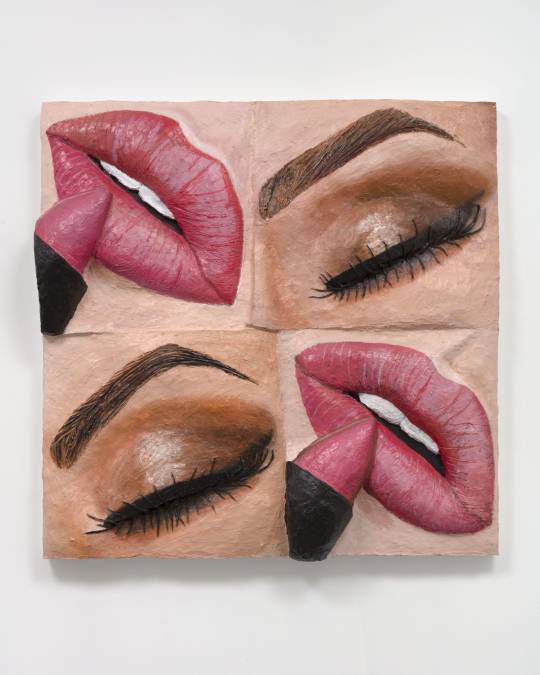



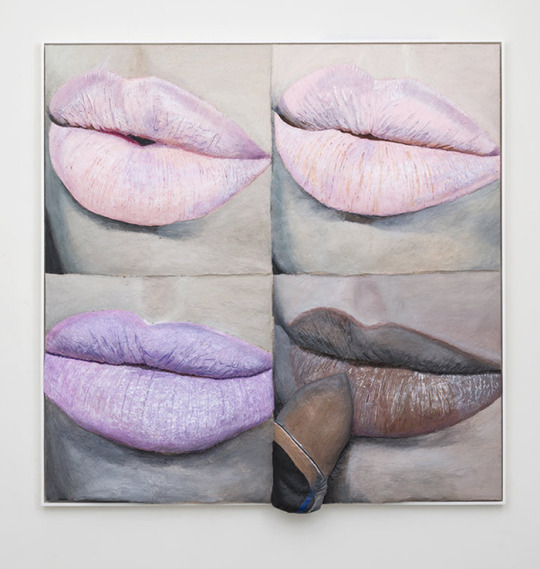


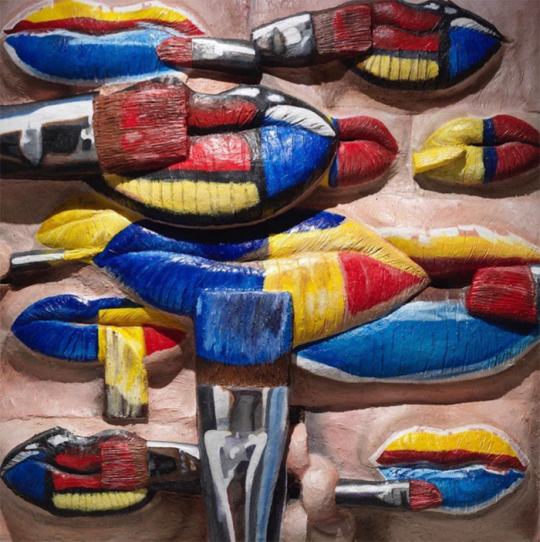
Artist Gina Beavers Satirizes Our Insatiable Appetite for Personal Beauty in Her New Show at Marianne Boesky
Makeup as Muse: Gina Beavers
November 28, 2020
Despite my art history background and general love of art, I am less than eloquent when writing about it. Nevertheless I will continue soldiering forward with the Museum's Makeup as Muse series, the latest installment of which focuses on the work of Gina Beavers in honor of her recent show at Marianne Boesky Gallery. Beavers' practice encompasses a variety of themes, but it's her paintings of makeup tutorials that I'll be exploring. Since I'm both tired and lazy this will be more of a summary of her work rather than offering any fresh insight and I'll be quoting the artist extensively along with some writers who have covered her art, so most of this will not be my own words.
Born in Athens and raised in Europe, Beavers is fascinated by the excess and consumerism of both American culture and social media. "I don't know how to talk about this existence without talking about consumption, and so I think that's the element in consuming other people's images. That's where that's embedded. We have to start with consumption if we're going to talk about who we are. That's the bedrock—especially as an American," she says. The purchase of a smart phone in 2010 is when Beavers' work began focusing on social media. "[Pre-smart phone] I would see things in the world and paint them! Post-smartphone my attention and observation seemed to go into my phone, into looking at and participating in social media apps, and all of the things that would arise there...Historically, painters have drawn inspiration from their world, for me it's just that a lot of my world is virtual [now]."
But why makeup, and specifically, makeup tutorials? There seem to be two main themes running through the artist's focus on these online instructions, the first being the relationship between painting and makeup. Beavers explains: "When I started with these paintings I was really thinking that this painting is looking at you while it is painting itself. It’s drawing and painting: it has pencils, it has brushes, and it’s trying to make itself appealing to the viewer. It’s about that parallel between a painting and what you expect from it as well as desire and attraction. It’s also interesting because the terms that makeup artists use on social media are painting terms. The way they talk about brushes or pigments sounds like painters talking shop." Makeup application as traditional painting is a theme that goes back centuries, but Beavers's work represents a fresh take on it. As Ellen Blumenstein wrote in an essay for Wall Street International: "Elements such as brushes, lipsticks or fingers, which are intended to reassure the viewers of the videos of the imitability of the make-up procedures, here allude to the active role of the painting – which does not just stare or make eyes at the viewer, but rather seems to paint itself with the accessories depicted – literally building a bridge extending out from the image...Beavers divests [the image] of its natural quality and uses painting as an analytical tool. The viewer is no longer looking at photographic tableaus composed of freeze-frames taken from make-up tutorials, but rather paintings about make-up tutorials, which present the aesthetic and formal parameters of this particular class of images, which exist exclusively on the net." The conflation of makeup and painting can also be perceived as a rumination on authorship and original sources. Beavers is remaking tutorials, but the tutorials themselves originated with individual bloggers and YouTubers. And given the viral, democratic nature of the Internet, it's nearly impossible to tell who did a particular tutorial first and whether tutorials covering the same material - say, lip art depicting Van Gogh's "Starry Night" - are direct copies of one artist's work or merely the phenomenon of many people having the same idea and sharing it online. Sometimes the online audience cannot distinguish between authentic content and advertising; Beavers's "Burger Eye" (2015), for example, is actually not recreated from a tutorial at all but an Instagram ad for Burger King (and the makeup artist who was hired to create it remains, as far as I know, uncredited).
Another theme is fashioning one's self through makeup, and how that self is projected online in multiple ways. Beavers explains: "I am interested in the ways existing online is performative, and the tremendous lengths people go to in constructing their online selves. Meme-makers, face-painters, people who make their hair into sculptures, are really a frontier of a new creative world...It’s interesting, as make-up has gotten bigger and bigger, I’ve realized what an important role it plays in helping people construct a self, particularly in trans and drag communities. I don’t normally wear a lot of make-up myself, but I like the idea of the process of applying make-up standing in for the process of self-determination, the idea of ‘making yourself’."
As for the artist's process, it's a laborious one. Beavers regularly combs Instagram, YouTube and other online sources and saves thousands of images on her phone. She then narrows down to a few based on both composition and the story they're trying to tell. "I'm arrested by images that have interesting formal qualities, color, composition but also a compelling narrative. I really like when an image is saying something that leaves me unsure of how it will translate to painting, like whether the meaning will change in the context of the history of painting," she says. "I always felt drawn to photos that had an interesting composition, whether for its color or depth or organization. But in order for me to want to paint it, it also had to have interesting content, like the image was communicating some reality beyond its composition that I related to in my life or that I thought spoke in some interesting way about culture." The act of painting for Beavers is physically demanding as well: she needs to start several series at the same time and go back and forth between paintings to allow the layers to dry. They have to lay flat to dry so she often ends up painting on the floor, and her recent switch to an even heavier acrylic caused a bout of carpal tunnel syndrome.
But it's precisely the thick quality of the paint that return some of the tactile nature of makeup application. This is not accidental; Beavers intentionally uses this technique as way to remind us of makeup's various textures and to ensure her paintings resemble paintings rather than a photorealistic recreation of the digital screen. "The depth of certain elements in the background of images has taught me a lot about seeing. I think I have learned that I enjoy setting up problems to solve, that it isn't enough for me to simply render a photo realistically, that I have to build up the acrylic deeply in order to interfere with the rendering of something too realistically," she explains. Sharon Mizota, writing for the LA Times, says it best: "Skin, lashes and lips are textured with rough, caked-on brushstrokes that mimic and exaggerate wrinkles and gloppy mascara. This treatment gives the subjects back some of the clunky physicality that the camera and the digital screen strip away. Beavers’ paintings, in some measure, undo the gloss of the photographic image."
Beavers also uses foam to further build up certain sections so that they bulge out towards the viewer, representing the desire to connect to others online. "Much of what people do online is to try to create connection, to reach out and meet people or talk to people. That is what the surfaces of my painting do in a really literal way, they are reaching off the linen into the viewer’s space," she says. This sculptural quality also points to the reality of the online world - it's not quite "real life" but it's not imaginary either, occupying a space in between. Beavers expands on her painting style representing the online space: "It’s interesting because flatness often comes up with screens, and I think historically the screen might have been read like that, reflecting a more passive relationship. That has changed with the advent of engagement and social media. What’s behind our screen is a whole living, breathing world, one that gives as much as it takes. I mean it is certainly as 'real' as anything else. I see the dimension as a way to reflect that world and the ways that world is reaching out to make a connection. Another aspect is that once these works are finished, they end up circulating back in the same online world and now have this heightened dimensionality – they cast their own shadow. They’re not a real person, or burger, or whatever, but they’re not a photo of it either, they’re something in between."
Let's dig a little more into what all this means in terms of makeup, the beauty industry and social media. Beavers' work can be viewed as a simultaneous critique and celebration of all three. Sharon Mizota again: "[The tutorial paintings] also pointedly mimic the act of putting on makeup, reminding us that it is something like sedimentation, built up layer by layer. There is no effortless glamour here, only sticky accretion. That quality itself feels like an indictment — of the beauty industry, of restrictive gender roles. But an element of playfulness and admiration lives in Beavers’ work. They speak of makeup as a site of creativity and self-transformation, and Instagram and other social media sites as democratizing forces in the spread of culture. To be sure, social media may be the spur for increasingly outré acts, which are often a form of bragging, but why shouldn’t a hamburger eye be as popular as a smoky eye? In translating these photographs into something more physical, Beavers asks us to consider these questions and exposes the duality of the makeup industry: The same business that strives to make us insecure also enables us to reinvent ourselves, not just in the image of the beautiful as it’s already defined, but in images of our own devising."
This ambiguity is particularly apparent in Beavers's 2015 exhibition, entitled Ambitchous, which incorporated beauty Instagrammers and YouTubers' makeup renditions of Disney villains alongside "good" characters. Blumenstein explains: "So it isn’t protagonists with positive connotations which are favoured by the artist, but unmistakably ambivalent characters who could undoubtedly lay claim to the neologism ambitchous, which is the name given to the exhibition. Like the original image material, this portmanteau of ‘ambitious’ and ‘bitchy’ is taken from social media and its creative vernacular, and is used, depending on the context, either in a derogatory fashion – for example for women who will do absolutely anything to get what they want – or positively re-interpreted as an expression of female self-affirmation. Beavers also applies this playful and strategic complication of seemingly unambiguous contexts of meaning to the statements contained in her paintings. It remains utterly impossible to determine whether they are critically exaggerating the conformist and consumerist beauty ideals of neo-capitalism, or ascribing emancipatory potential to the conscious and confident use of make-up."
More recently, Beavers has been using her own face as a canvas and making her own photos of them her source material, furthering her exploration of the self. "Staring at yourself or your lips for hours is pretty jarring. But I like it, because it creates this whole other level of self,” she says.
This shift also points to another dichotomy in Beavers's work: in recreating famous works of art on her face, she is both critiquing art history's traditional canon and appreciating it, referring to them as a sort of fan art. "I think a lot of the works that I have made that reference art history—like whether it's Van Gogh or whoever it is—have a duality where I really respect the artist and I'm influenced by them, and at the same time I'm making it my own and poking a little fun. And so, a lot of these pieces originated with the idea of fan art. You'll find all sorts of Starry Night images online that people have painted or sculpted or painted on their body. It comes out of that. And I just started to reach a point where I was searching things like 'Franz Kline body art,' and I wasn’t finding that, so I had to make my own. Then it started to get a little bit geekier. I have a piece in the show where I am painting a Lee Bontecou on my cheek, that's a kind of art world geeky thing—you have to really love art to get it."
Ultimately, Beavers perceives the intersection of makeup and social media as a force for good. While the specter of misinformation is always lurking, YouTube tutorials and the like allow anyone with internet access to learn how to do a smoky eye or a flawlessly lined lip. "I think for a lot of people social media is kind of like the weather. We don't have a lot of control of it, it just is. It gives and it takes away. There's no doubt that it has connected people in ways that are great and productive, allowing people to find communities and organize activism, it can also be a huge distraction...I approach looking at images there pretty distantly, more as a neutral documentarian, and I come down on the side of seeing social media as an incredibly useful, democratic tool in a lot of ways," she concludes.
On the other side of social media, Beavers is interested on how content creators help disseminate the idea of makeup as representing something larger and more meaningful than traditional notions of beauty. "I was super fascinated with makeup and all of the kinds of costume makeup and things you can find online that go away from a traditional beauty makeup and go towards something really wild and cool...I also had certain paintings in [a 2016] show that were much more about costume makeup, that were going away from beauty. That’s the thing that gives me hope. When I go through makeup hashtags on Instagram, there will be ten or twenty beauty eye makeup images and then one that’s painted with horror makeup. There are women out there doing completely weird things, right next to alluring ones." In the pandemic age, as people's relationships with makeup are changing, "weird" makeup is actually becoming less strange. Beavers' emphasis on experimental makeup is more timely than ever. I also think she's documenting the gradual way makeup is breaking free of the gender binary. She says: "I mean with makeup, and the whole conversation around femininity and makeup—I think for a long time when I was making makeup images, there were people that just thought, 'Oh, that's not for me,' because it's about makeup, it's feminine. But it’s interesting, the culture is shifting. I just saw the other day that Alexandria Ocasio-Cortez did a whole Instagram live where she was putting on her makeup and talking about how empowering makeup is for trans communities...some people see make-up as restrictive or frivolous, but drag performers show how it can be liberating and life-saving." Another point to consider in terms of gender is the close-up aspect of Beavers's paintings. With individual features (eyes, lips, nails) separated from the rest of the face and body and removed from their original context, they're neither masculine nor feminine, thereby reiterating that makeup is for any (or no) gender.
All I can say is, I love these paintings. Stylistically, they're right up my alley - big, colorful and mimicking makeup's tactile nature so much that I have a similar reaction to them as I do when seeing makeup testers in a store: I just want to dip my hands in them and smear them everywhere! I also enjoy the multiple themes and levels in her work. Beavers isn't commenting just on makeup in the digital age, but also self-representation online, shifting attitudes towards makeup's meaning, the relationship between painting and makeup, and Western art history.
What do you think of Beavers's paintings?
1 note
·
View note
Text
Bianca Bosconero - Snow White stayed in the wild (Interlude 2)
Who is up for some fashion talk? I certainly am! ( @tsuisute making this post got me in a fashion commentary mood lol sorry I lowkey highjacked your height chart posts)
Considering the general atmosphere of the Valley of Thorns (based on what we know so far, at least), I decided to go the fashion history way with my OCs, though I hit different time periods because I feel like the styles would fit each of them - and also because, having a twin brother IRL, I despise the “they’re twins so they must look/act alike” trope (uninspired, unimpressive). The only moment when I’m ok with it is when the twins in question have obviously different style and personality despite their generally similar face - so I’m ok with the eelboys, for example, because they very obviously are their own persons despite working as a team.
There’s gonna be illustrations so check under the cut!
With that said, as far as Bianca is concerned, I went for a modernised Edwardian aesthetic. So rather than aiming for the hour-glass figure that is in favour again nowadays (it was also all the rage during the Victorian era), I’m going for a clean, S-shaped silhouette.
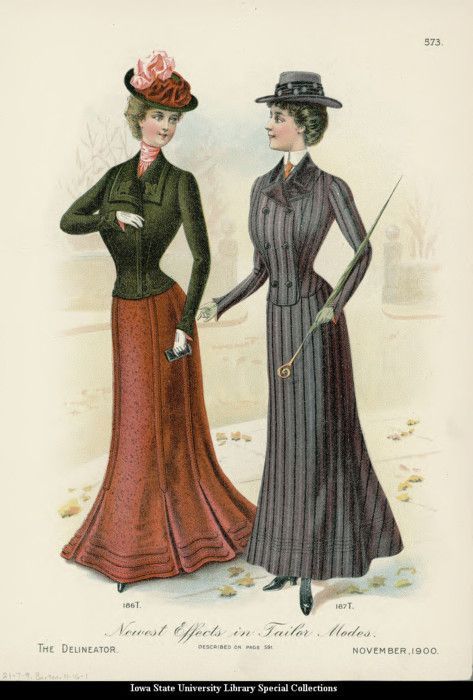
Of course, over the span of about 30 years, the silhouette has known variations (especially with the use of a bustle in the first half, or with the length of the jacket), so I’m precisely aiming for a silhouette similar to the one depicted in the gravure above for Bianca’s school uniform. A crisp line with a natural waist and elements of the outfit based on masculine fashion. The following breakdown of Rosalind Lutece’s (Bioshock Infinite) outfit provides a concise, visual explanation of the layers women would wear during the Edwardian era:

While it’s not exactly what Bianca wears - especially when it comes to the underwears, it should help understand where I’m coming from with her cothing style. In her case, her underwears are more modern and include a body shaping slip dress to smooth all the lines. I considered going full corsetry initially, but yeah, modern clothing got the better of me (even though a properly fitted corset is, actually, very comfortable). Still, I’m on board with a potential small bustle to help give even more shape to the silhouette, and the slip dress definitely includes garters to keep the oldschool touch - however, those are not visible. At all. This is a school setting and Bianca possesses enough sense of decorum to pay attention and make sure everything is elegant. Besides, the contrary would be very out of character for her, and she doesn’t feel like she needs to use her physical charms anyway, so she expresses herself differently. From a meta point of view, this style also suits her strong interest for anything historical, I simply can’t see her go for something really modern.
Regarding the length and cut of her school skirt, the goal is to have a crisp line with a flair and clever pleating in the back to help provide shape and balance the waist/hips ratio in a feminine way. This is of course supported with the help of the small aforementioned bustle. And I’ll let Bernadette Banner explain the intricaties of such piece of clothing with her video regarding the creation of a 1895 walking skirt. However, the one I had in mind is another of Bernadette Banner’s projects, the modernised Edwardian walking skirt, set below the knee rather than at the ankle. These two videos should give you an idea of the shape and flow of the skirt, and used without corset/bodice in a manner matching Bianca’s appearance.
Now, onto her dorm uniform. There isn’t much to say, really. She wears it just like everybody else in Pomefiore. However, the purple overdress is definitely ankle-length in her case. Also, I mentioned in her profile that Bianca was unhappy with the over-the-ankle height of the boots, so she had them modified and turned into thigh high boots instead (to Vil’s displeasure)... Well my reference is riding boots men would wear during the late years of Louis XV’s reign. Let me give you two examples with the series Nicolas Le Floch (French series of police investigations in the historical context of Louis XV and Louis XVI’s reigns. There are novels, comics and a TV series, 10/10 would recommend):


As you can see, the man in both pictures wears tall leather riding boots - the second picture is especially relevant since it’s a historical recreation for the TV series. It’s that sort of shape I have in mind, with a bit of a heel to make it more “urban” (if you will). While she’s well dressed, Bianca basically gives the impression she’s ready to hop on a horse for a ride in the countryside, it constrats with Vil’s more feminine and delicate look. When it comes to her makeup, however, she changed it at the start of her second second year (eh). Before, she had the same classic smokey brown style she normally wears with her school uniform, but now she transitioned to something more spectacular, as if she was putting her foot down and saying “I’m here now”. Of course, the colours match with her dorm uniform, contrast nicely with her eyes, and in my opinion it is very much in the style of Leesu’s vampire makeup.
Anyway that was my fashion interlude, this weekend I’ll get back to a normal rhythm and prepare the post detailing Bianca’s unique magic, before switching to Neve’s profile, backstory and unique magic! Stay tuned!
#twisted wonderland#disney twisted wonderland#twst#twisted wonderland oc#twst oc#OC#bianca bosconero#aaaah fashion history#one of my favourite topics#up there with makeup skincare and haircare
14 notes
·
View notes
Text
Rando Munday ramblings! For new followers, on Munday sometimes I just post a bunch of personal stuff I normally wouldn’t. Not usually anything intimately personal, more like random thoughts and news that just isn’t relevant to the blog in any way, not related to X-Men or RP or writing in general, etc.
....there’s a lot of Hannibal today, sorry, I’m rewatching it.
- I definitely wanna have a pair of critters named Hannibal and Hasdrubal at some point, maybe if there's a third I'd name him Hamilcar. I know everyone will think I named them after Hannibal Lector but actually these are really common names from Ancient Carthage. Like if you look at Carthagian history and records, everyone is Hannibal, Hasdrubal, or Hamilcar, it's like John, James, and Jim. I'd prefer the pair, though, since Hannibal and Hasdrubal were a pair of brothers and famous historical figures, so it would feel much more like a "set" that way (whereas they did not have a brother called Hamilcar)
- Speaking of Hannibal Lector, I knew he was based on a real person, but I did not realize that person was a gay Mexican man. That’s...an interesting example of gay history, for sure. If you don’t know what I’m talking about, Thomas Harris (the writer of the books that the films and later the TV series were based on) based Hannibal on a surgeon he met while interviewing an inmate at prison for another novel. This surgeon was so intelligent and charismatic that Harris implicitly assumed that he was a doctor in the employ of the prison. Nope---the doctor was an inmate himself. Harris was so shaken by the encounter that it inspired him to create Hannibal Lector, who, in contrast to the typical media portrayals of serial killers as uncontrolled lunatic slashers like Michael Myers or Leatherface, is a charming, culture, charismatic intellectual.
To protect the man’s identity, Harris called him “Dr. Salazar” in interviews, so that was always how I knew him. I just now learned not only was his real name Alfredo Balli Trevino, but his victim was Jesus Castillo Rangel, his male lover. Harris describes him as a small, lithe man with dark red hair and, unsurprisingly, “a certain elegance about him”. Though Trevino was given the death penalty for his crimes, his sentence was commuted to 20 years and he was released in either 1980 or 1981. He died in in 2009 when he was 81 years old. He reportedly spent the last years of his life helping the poor and elderly, and he expressed deep regret for his “dark past”---which I suppose makes sense, since his crime was that he killed a lover in a fit of rage during an argument, whereas Hannibal simply killed people in cold blood whom he had no attachment to because he liked eating them (something Trevino never did) and to punish them for rudeness.
- I’ve decided to stop buying silk, unless it's from a thrift store and thus my money won't go to supporting sericulture. Ahimsa silk isn't an option either, the bugs aren't technically killed but they're not treated well either. I know it might seem weird to eat meat and wear leather and yet not want to purchase something that hurt moths and larva, but...I have to eat meat for medical reasons, and my leather purchases is limited to boots that I then keep for YEARS AND YEARS so it's very sparing. There's really no such thing as a cruelty-free diet or lifestyle, whether that cruelty is suffered by animals or by other humans, but I can still make choices that at least lesson some small aspect of harm. I need to eat meat, I don't need real silk.
...Haven only wears bamboo silk for this reason and when this came up with Shaw, he absolutely thought she was fucking with him, like even SHE can’t be THIS insane, NO ONE ACTUALLY CARES ABOUT BUGS WTF
- The books nearest to me right now are “Women Who Run With The Wolves: Myths and Stories of the Wild Woman Archetype ” by Clarissa Pinkola Estes, The Norton Anthology of English Literature: The Romantic Period, “X-Men: The Legacy Quest Trilogy” by Steve Lyons, two horror anthologies, the script for “M. Butterfly” by David Henry Hwang, “The Spanish Riding School of Vienna: Tour of America 2005″ book I got from when I went to see the Lippizanner horses perform, and a big beautiful leatherbound English translation of “The Flowers of Evil” by Charles Baudelaire. This is...this is a summary of my whole personality, sans rodents. Also god I need to clean my room.
- Something I've noticed is that many sci-fi horror films that do the whole "science went too far against nature!!!" thing....don't actually have the problem result from the lack of ethics involved or because the scientists did something "unnatural", it happens because they didn't follow basic safety precautions, lab protocol, common sense, etc.
"Splice" for instance, is a really good example---the problem isn't that they made a part-human hybrid, that's not why shit goes wrong, shit goes wrong because the two scientists act like idiots, adopt the creation as a child, hide it in their barn instead of a sterile controlled environment, and then one of them HAS SEX WITH IT. Or in "The Fly" the problem isn't that Brundle invented a teleporter, it's that he tested it ON HIMSELF while he was ALL ALONE. Even in "Jurassic Park" the issue is less that dinosaurs are breeding and more the result of a disgruntled worker who was given way too much power over being able to run things, and thus shut them down when he wants to. So many "science gone wrong!" movies end up not really being condemnations of science itself, so much as depicting scientists as utter dumbasses.
Which, on the one hand, I do like, because I dislike the notion of condemning scientific progress just because it seems icky or creepy or "goes against nature" (so do vaccines, I still like those!) But on the other hand, the movies don't FRAME it as "this is the result of failure to practice science safely and sensibly" they frame it as "they should never have attempted such an unnatural thing and this disaster is punishment for a moral sin" even though the issue doesn't happen because what the scientists did was "wrong" it happens because they do something DUMB.
- Bringing it back to Hannibal, I reached the episode where Margot Verger first appears, and if I have one big disappointment about the Hannibal series, it's Margot. In the books, she's a huge butch lesbian, literally and figuratively. In the TV series, she's a pretty femme fashionista like all the other women, and she fucks Will in order to get pregnant.
At the time this came out in 2013, I tried to be all resigned and fair-minded about this. I was like "ok, well, they didn't want to be offensive with a stereotype, and I guess that's fair, I guess not hurting people matters more to me than getting the horseback-riding bulldyke hearthrob of my high school years on-screen at last" but you know what? No.
Firstly, butch lesbians deserve representation too. How many have you ever seen onscreen, let alone in a mainstream media production? Sure, it's a stereotype, but it's not an inherently negative one, they just get treated that way in media because society sees it that way. But the way to handle butch lesbians and femme gay men and so on isn't to erase them from the screen, it's to start writing them as human beings and not caricatures or jokes or monsters. Margot is a fleshed-out human being, she's nuanced and twisted and hurt like everyone else in this series, she would be PERFECT for that. She wouldn't be just a butch lesbian, she'd be a CHARACTER who just also happens to be a butch lesbian. I don't really think she was changed to avoid "hurting" lesbians, I think she was changed because the director, gay man or not, clearly has a way he wants the women in his series to look (they're all fashion plates, all have long hair, all very sophisticated, etc) and book Margot didn't fit his aesthetic, his design if you will. Because god forbid we just make her a DAPPER dyke, right?
Back to having sex with Will, which most certainly did NOT happen in the books...that's not bad itself in a VACUUM, fucking men to get a baby is something real-life lesbians do, I had a friend in college who was actually conceived that way, but like...no media exists in a vacuum, and there is very little depiction of lesbians in media that doesn't feature them fucking men for SOME reason or another. They want a baby, or they start the story with a boyfriend, or they're actually bisexual, or they're even raped, but there's always SOME reason we have to watch a guy fucking them and it's frankly distressing. Like, remember Irene Adler in BBC's Sherlock? It's a pattern. And I'm not saying lesbians who have had a sexual past with men, or who were the victims of sexual violence by men, don't deserve representation, I would never say that, those are very common experiences, I'm not saying "gold stars only", I'm saying that there is a strong pattern in media where it seems almost obligatory that a lesbian has to have sex with or be attracted to men at some point, while comparatively the opposite case, where a lesbian is depicted as exclusively and only attracted to and "with" other women, is seldom there.
And it's just kind of a kick in the nads for me, as I think it was for a lot of other lesbians, butch or not, that a gay director took an opportunity like Margot Verger and turned her into just another attractive lipstick lesbian that is okay with having sex with the male protagonist as a treat tee hee
(Spoiler: She does end up with Alana though, which I appreciate)
3 notes
·
View notes
Photo

FLASHBACK FRIDAY~
Without question, the most significant event of the last decade came to me in the form of a radio show in 2017. To the surprise of everyone participating in the show, a PETA spokesperson issued a statement sanctioning the use of humanely acquired dead animals for the purpose of art.
It was an episode of The Current on CBC radio, hosted by the acclaimed radio and television journalist Anna Maria Tremonti. The show was about the genre of rogue taxidermy art and how the genre spurred the current taxidermy revival. The show featured several interviews with people associated with rogue taxidermy. As co-founder of the genre and the subsequent artistic movement, I was among the interviewees. The genre was the brainchild of co-founder Scott Bibus, co-founder Robert Marbury, and myself. In 2004 we coined the term “rogue taxidermy” and formed an online artist collective based on our respective styles of sculpture. We then began recruiting artists working in a similar vein to join our collective and unite under the moniker of rogue taxidermy. The definition of rogue taxidermy that we set forth is: “A genre of pop-surrealist art characterized by mixed media sculptures containing conventional taxidermy-related materials that are used in an unconventional manner”. The genre encompasses a variety of materials and doesn’t always involve animal parts, it can be entirely synthetic. However, the foundation of our collective was a doctrine that mandated animals could not be killed for the sake of art and all members of the group were required to adhere to this directive. Ultimately our efforts led to the collective spearheading an international artistic movement centered around our ideology and our aesthetic. It became known as the Rogue Taxidermy art movement. Predictably, PETA denounced it.
Prior to forming our collective I had a long history of using animal remains in my art. And a long history of receiving pushback. I began incorporating animal parts into my art in the early 1990’s while earning my BFA from the Minneapolis College of Art and Design. Because of my love for animals, the philosophy underlying my work dictated that I only use animals that died of natural causes and roadkill. Out of respect for Mother Nature my mantra in the studio was “waste not, want not” because nothing that was once living should ever be taken for granted. So when I sat down with my fellow co-founders, Scott Bibus and Robert Marbury, to write up a charter for membership to our collective I clearly needed those precepts to be included. We wove them into the philosophical framework of the genre and this code of ethics was explicitly laid out on our collective’s website, just as it had been laid out on my own personal website for many years prior to forming the collective. My ethical practices had always been front and center on my personal website in the form of my artist statement and biography. My site conveyed the special bond I had with animals during my formative years and how the intimate relationships I had with them shaped my art. It explained how my work was an homage to the animal. How turning an animal’s body into a piece of art was the purest form of veneration; a type of veneration akin to the bejeweled remains of saints enshrined in Medieval Churches, or to the Victorian practice of creating mourning art out of the hair and teeth of deceased loved ones. I talked about my work being deeply rooted in a personal belief system that could be traced back to my childhood; a belief system that occupied the same place in my psyche that formal religion occupied in other people’s psyche. My work was a form of zoolatry.
But none of that mattered to my sanctimonious haters. I was persecuted for my belief system for years. The lambasting often came from hypocrites who experienced no moral dilemma when eating or wearing a cow, yet they had a problem with me utilizing roadkill. It was the early 1990's and using an animal’s body in art was taboo. Animal activists throwing red paint onto the fur coats of celebrities and fashion runways was at the height of its popularity during this era. I was the victim of bullying for nearly 20 years in the form of endless hate mail, death threats, and being slandered in literature by prominent animal rights authors. The attacks generally had one of two themes; my art was disrespectful, and/or I needed to give the animals a proper burial. Apparently all animals are Christian LOL…. FTR, burying the dead would be sacrilege in many cultures… But I digress. I never lashed out at my critics. Instead, I spent endless hours of my life responding to their misdirected hate with courteous email responses that reiterated the principles behind my work. I attempted to initiate conversations about tolerance by gently reminding them it was not their place to impose their standards, customs, and beliefs on other people (or onto a dead animal...) The concept of reverence is contingent upon intent and context. No one has the right to decide how someone else is allowed to venerate something. Nor does anyone have the right to force their aesthetics on someone else simply because something doesn’t appeal to their tastes. Beauty is in the eye of the beholder. This (uphill) battle continued for years.
So fast forward to 2017... Never in my wildest fantasies did I think I would someday be sitting in a radio broadcasting booth where the sound bite following my interview would be a PETA representative speaking these words:
“[When discussing rogue taxidermy] The most important thing is to look at how the animal died. If the animal died naturally or in an accident, then PETA doesn’t have a problem with preserving their carcass. . .”
The moment was surreal. Our mission finally resonated with the largest animal rights group in the world. And in that moment, this became a landmark radio broadcast. It was testament to the merit of our core values. Those of us who fought on the front lines took flak for decades as we carved out our niche. In doing so, we laid a path for others to follow. And many did. Via strength in numbers, and sheer perseverance, dialogue developed that began engaging the mainstream. Dialogue about human/animal relationships. About how humans process death. About the concept of reverence. And about making space for practices outside those of the dominant culture. The radio show was an achievement of a lifetime for me. Appeasing PETA was never a goal, and that’s not the achievement. (I have probably taken issue with as many of their activities over the years as they have taken with mine.) The fact that they acknowledged our mission represented a higher accomplishment – it was an indicator that the movement’s ideology had influenced mainstream sensibilities. As an artist who has had to defend her work and her character for her entire life, it was incredibly validating in that regard. PETA’s statement was vindication of the tenets I had been actively championing for a quarter of a century.
The "no kill" ethics platform of the Rogue Taxidermy art movement is a first-of-a-kind. Prior to the inception of the genre of Rogue Taxidermy art, never before in history had taxidermy been associated with the humane sourcing of animals. Conversely, taxidermy had been associated with the killing of animals. This stigma created a seemingly insurmountable hurdle for the movement. Historically, all groundbreaking cultural movements were considered deviant and radical at their inception. Encountering resistance is part of the birth of any movement that calls into question long-standing traditions and moral standards. But challenging established societal norms is how horizons are broadened and new concepts are assimilated. It's the fundamental basis of how culture evolves.
Clearly the statement issued by PETA is in no way saying all art created within the genre of Rogue Taxidermy is acceptable to them. Not everyone working under the umbrella of Rogue Taxidermy adheres to the genre’s cornerstone values. There is no lack of people exploiting the genre’s popularity to line their own pockets. I regularly see the catchphrase “ethically-sourced” thrown around in situations where that descriptor is a real stretch. Of course there are gray areas, and of course there is room for interpretation on both sides of the fence. However, PETA’s statement was inarguably a milestone; one that was reached after an arduous journey of baby steps. To the artists working within the genre who are purists, and as such practice true humane-sourcing of their animals; hats off to every single one of you. #You’veComeALongWayBaby
__________________________________________________
I encourage you to replace your daily podcast time slot with this radio broadcast. It’s worth every second of the 20-minute time investment, especially the last half – You absolutely don’t want to miss the extremely insightful interview with author, lecturer, and researcher Joanna Ebstein, founder of the Morbid Anatomy Museum. The segment also features the immensely talented Beth Beverly who was a fellow member of the rogue taxidermy artist collective.
Click here to listen to the show ~
__________________________________________________
Unabridged history of the art movement
https://www.sarina-brewer.com/introduction.html
My biography & artist statement
https://www.sarina-brewer.com/taxidermy-sculpture-artist-sarina-brewer.html
_________________________________________________
#FeministArt#WomenInArt#RogueTaxidermy#PETA#Ethics#AnimalsInArt#AnimalRights#AnimalWelfare#Conservation#EthicalArt#TaxidermyArt#Tolerance#Progress#Culture#ArtMovement#Philosophy#FlashbackFriday#FBF#You've come a long way baby
6 notes
·
View notes